Not with ink, but with blood and tears The
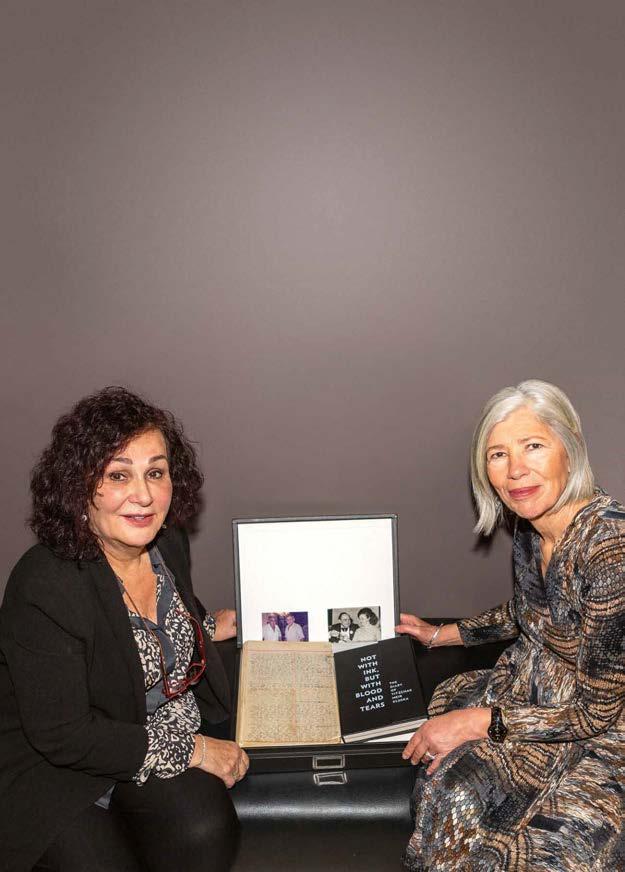
diary of Yitzchak Meir Kluska
News SEPTEMBER 2018 The magazine of the Jewish Holocaust Centre, Melbourne, Australia Registered by Australia Post. Publication No. VBH 7236
Centre
JHC Board:
Co-Presidents
Pauline Rockman OAM
and Sue Hampel OAM
Treasurer Richard Michaels
Vice-President David Cohen
Secretary Elly Brooks
Other Directors
Allen Brostek
Anita Frayman
Abr am Goldberg OAM
Paul Kegen
Phil Lewis
Helen Mahemoff
Melanie Raleigh
Mary Slade
The Jewish Holocaust Centre is dedicated to the memory of the six million Jews murdered by the Nazis and their collaborators between 1933 and 1945.
We consider the finest memorial to all victims of racist policies to be an educational program that aims to combat anti-Semitism, racism and prejudice in the community, and fosters understanding between people.
JHC Foundation:
Chairperson
Trustees
Helen Mahemoff
Nina Bassat AM
Joey Borensztajn
Allen Brostek
David Cohen
Jef frey Mahemoff AO
JHC Staff:
Executive Director War ren Fineberg
Curator and
Head of Collections
Director of Education
Director of Community
Jay ne Josem
Lis a Phillips
Relations & Research Dr Michael Cohen
Director of Marketing & Development Leora Harrison
Director of
Testimonies Project Phillip Maisel OAM
Librarian/Information Manager Julia Reichstein
Senior Archivist Dr Anna Hirsh
Audio-Video Producer
Education Officers
Marketing Manager
Executive Assistant
Finance Officer
Office Manager
Communications Officer
Volunteer Coordinator
Bookkeeper
Database Coordinator and IT Support
Centre News:
Editor
Yiddish Editor
Robbie Simons
Fiona Kelmann
Anatie Livnat
Fanny Hoffman
Danielle Kamien
Evelyn Portek
Leon Mandel
Lena Fiszman
Tosca Birnbaum
Rae Silverstein
Daniel Feldman
Daniel Feldman
Ruth Mushin
Alex Dafner
13–15 Selwyn Street
Elsternwick Vic 3185
Australia
t: (03) 9528 1985
On the cover:
Genia Janover and Judy Kluska with Yitzchak Meir Kluska’s diary
Photo: Zina Sofer
This publication has been designed and produced by Grin Creative / grincreative.com.au
f: (03) 9528 3758
e: admin@jhc.org.au
w: www.jhc.org.au
OPENING HOURS
Mon–Thu: 10am–4pm Fri: 10am–3pm
Sun & Public Hols: 12pm–4pm
Closed on Saturdays, Jewish Holy Days and some public holidays
Disclaimer: The opinions expressed in Centre News are those of the authors and do not necessarily reflect those of the magazine editor or editorial committee. While Centre News welcomes ideas, articles, photos, poetry and letters, it reserves the right to accept or reject material. There is no automatic acceptance of submissions.
IN THIS ISSUE From the Presidents 3 Editor’s note 3 Director’s cut 4 Education 4 Precious new arrival: a Torah scroll that survived the Holocaust 5 Remember the past – build the future 6 Not with ink, but with blood and tears 10 Survivors remember the Warsaw Ghetto Uprising 12 Jewish life in Germany today 14 Failing to understand failure: reassessing the Evian Conference of 1938 16 Anita Selzer in conversation with Lisa Phillips 20 Jewish Rescuer Citation awarded to Ronia Rozental 22 Lowicz: a city sentenced to death 23 My Holocaust memorial year abroad at the Jewish Holocaust Centre 24 Hope for a better future 25 Keeping their memories alive 26 Ex tracts from my MOTL journal 27 JHC Social Club 28 Young Friends of the Jewish Holocaust Centre 29 Seen around the Centre 30 New acquisitions 32 Celebrating through giving 33 Community news 34
From the Presidents
Pauline Rockman OAM and Sue Hampel OAM

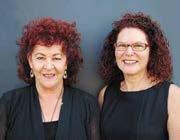
Dr Anna Hirsh, Senior Archivist at the Jewish Holocaust Centre (JHC) brought out a miniature notebook not much larger than a 50-cent piece, totally covered in tiny handwriting in Polish: the diary of Romuald Mrozowski. It had been brought to the JHC by his stepdaughter at the suggestion of her son, who was so affected by his visit to the JHC as a high school student over 20 years ago that he thought it would be the best place for it. Romuald was involved in the Warsaw Uprising that took place one year after the Warsaw Ghetto Uprising, and was captured as a POW.
We thank our translators who bring amazing stories like this to a wider audience. They do a fantastic job deciphering difficult handwriting and dealing with difficult subjects.
The JHC Collection is our most treasured resource, and has immense cultural value within both Australian and Holocaust history. Comprising documents, photographs, artefacts, rare artworks and oral history recordings, the collection presents tangible evidence of the lives of those who suffered under Nazi persecution. Outstanding community support has enabled the JHC to use the most cutting-edge technologies in the collection and exhibition of priceless artefacts from the Holocaust period.
The JHC continues to be a hive of activity. We have recently hosted a number of public lectures and book launches, and the exhibition ‘Jewish Life in Germany Today’.
Mandy Myerson and Bianca Saltzman organised a commemorative event for Yom Hashoah at the JHC, attended by 250 young adults. We are very pleased to see the next generation’s interest and involvement in the area of Holocaust remembrance.
In May we attended the International Holocaust Remembrance Alliance (IHRA) plenary in Rome as part of the Australian delegation, in Australia’s new capacity as a liaison country. Australia will move to full IHRA membership by June 2019, and we are very grateful to Sir Eric Pickles and the English delegation for their guidance in this journey. Meeting and sharing information and resources is a great benefit of these sessions, not to mention hearing from Professor Yehuda Bauer, the IHRA honorary chair.
In June, Sue Hampel and Jayne Josem, JHC Curator and Head of Collections, gave presentations at Yad Vashem’s 10th International Holocaust Education Conference. The conference was attended by 350 delegates from over 50 countries.
The JHC education program attracts over 22,000 students from schools throughout Victoria. In addition, over 10,000 others visit the museum, and over 100 events are held throughout the
year. We are delighted that City of Glen Eira has approved our preliminary building plans and we can now move forward in redeveloping our facilities. We shall be retaining as much of the original building as practical, but our architect has incorporated sufficient space to meet the needs of the JHC for next 20 or more years.
Dear friends, our work is arguably even more relevant today than it was when the JHC was established in 1984, and we look forward to your support in this exciting development.
Editor’s
Ruth Mushin
Now that the preliminary plans for the redevelopment of the Jewish Holocaust Centre (JHC) have been approved, we are excited to bring you an artist’s impression of how the new building will look and some of the facilities it will house.
We continue to feature survivor stories in this edition of Centre News . Sam Brygel presents witness accounts of the Warsaw Ghetto Uprising taken from the JHC’s Phillip Maisel Testimony Project. These moving stories of survivors who were children and teenagers at the time bring to life memories of both the uprising and daily life in the ghetto. The late Yitzchak Meir Kluska’s story of survival in a claustrophobic bunker with six others in Jedrzejow, Poland, for two years during the war is another remarkable story. His family recently presented the JHC with his precious diary, written in Yiddish in that bunker. We also feature the story of another precious acquisition – a Czech Torah scroll from the town of Valasske Mezirici that was rescued from the Czech Republic and found its way to Melbourne.
Michaela Glass, the granddaughter of a Holocaust survivor and recipient of the Irene and Ignace Rosenthal Scholarship, presents a moving account of what happened to her grandfather’s hometown of Lowicz, Poland, during the Nazi occupation, and Professor Paul Bartrop writes a thoughtful analysis re-examining the impact of the Evian Conference of 1938. I hope you enjoy these and the many other articles in this edition.
JHC Centre News 3
note
Education Lisa Phillips Director’s cut Warren Fineberg

Ihave recently been on a two-week trip to Japan with my family, during which we visited the Hiroshima Peace Memorial Museum. While still in Melbourne I arranged for Mrs Tamura, a volunteer survivor guide, to show us through the park and museum. As we toured the remains of the Genbaku Dome and the various memorials to the victims, including those who helped the injured after the blast and subsequently succumbed to radiation poisoning, Mrs Tamura told us her story. She was a child when the bomb hit Hiroshima but had been sent on an errand a few kilometres from the site. Her parents, however, were in the explosion zone but miraculously survived. Mrs Tamura is a champion for peace and asks that we each do what is in our power never to allow a nuclear tragedy such as that experienced by Hiroshima and Nagasaki to be repeated. I felt humbled to have met Mrs Tamura and found strong parallels between her experience and the message of our Holocaust survivors in Melbourne.
I would like to welcome Danielle Kamien, our new Marketing and Communications Manager. Danielle is assisting the Jewish Holocaust Centre (JHC) to promote activities and events, and is involved in our fundraising efforts to help meet our operational requirements.
On the back cover of the last edition of Centre News, Holocaust survivor Sarah Saaroni OAM was featured calling on members of the community to consider donating Holocaust material to the JHC archives. I would like to remind families of survivors of the need to protect and preserve Holocaust artefacts for future generations, and ask that you endeavour to locate any material in your home that needs care. Curator Jayne Josem or Senior Archivist Dr Anna Hirsh will be happy to speak with you about the best way to preserve this material, and how to donate it to the Centre if you wish.
Plans for the new Centre have been approved by the City of Glen Eira, and Helen Mahemoff, Phil Lewis and Leora Harrison have been working tirelessly on preparations for a capital appeal. I encourage all our supporters to get behind this project that will deliver a major gift to all Victorians, and be an enduring legacy to our survivors and those who died in the Holocaust.
The Jewish Holocaust Centre (JHC) education programs continue to break student attendance records, with each session often booked with more than one school. This May, for example, 1,000 more students participated than in May last year. We have also seen an increase in bookings for the Hide and Seek program, our program specifically designed to meet the needs of younger students. This is a wonderful team achievement and I am grateful to all our survivors and volunteer guides who devote so much time and energy to ensure that we deliver excellent Holocaust education. I am also indebted to our educators Anatie Livnat, Fiona Kelmann and Fanny Hoffman, as well as Tosca Birnbaum and Rae Silverstein who work tirelessly behind the scenes.

We have welcomed a number of new guides to our weekday teams, which has enabled us to meet the increasing demands of the school programs. We have also welcomed two new Holocaust survivors as speakers: Ivan Jarny, who was a partisan, and Eva Telman who fled with her family to the USSR during the Second World War.
As personal accounts by survivors remain at the heart of our education programs, we have explored ways of enhancing the delivery of survivor stories by using video testimony. Showing video testimony with a survivor present, followed by a question and answer session, has proven to be most successful for students and survivors.
Through our Custodian of Memory program, we have developed a model of guiding in the museum if a Holocaust survivor is not present. Instead, the experience of individual survivors is delivered through scripted narrative and using the Eyewitness testimony film, created in early 2000. This model ensures that the survivor’s voice remains central to visitors’ experience in the museum.
Our professional development sessions, including the Rosalky Professional Development sessions at the beginning of each term, continue to be well attended as we strive to learn and become more skilled in our delivery of the material.
Having an exhibitor stand at teacher conferences has allowed the education team to promote the work of the JHC, as well as advise on teaching the Holocaust. We have attended the Victorian Association for the Teaching of English and History Teachers’ Association of Victoriaannual conferences, providing the opportunity for valuable discussion, as well as enabling us to present workshops on various themes related to the Holocaust.
4 JHC Centre News
In April, the Jewish Holocaust Centre (JHC) became the custodian of a precious Torah scroll. The scroll was presented to the Centre by the Memorial Scrolls Trust, a UK-based organisation whose mission since the 1960s is to conserve and preserve Czech Torah scrolls that survived the ravages of the Holocaust.

Dr Joseph Toltz, a Sydney academic who represents the Memorial Scrolls Trust in Australia, formally handed over the Torah scroll, which came from Valasske Mezirici, colloquially known as Valmez. The small Jewish community of Valmez had existed since the middle of the 19th century and in 1930 it comprised 150 people. The scroll, which was used in the synagogue, was one of 1,564 Torah scrolls from the provinces of Moravia and Bohemia that were rescued in Prague by a group of Czech Jews during the war, and later saved from neglect by British Jews when Czechoslovakia was under communist rule.
Almost the entire Jewish population of Valmez was murdered during the Holocaust, and this is the only sacred artefact that miraculously survived from that community. In presenting it to the JHC, Dr Toltz said, ‘As one of the premier institutions of Holocaust remembrance in Australia, I knew that you would be an excellent choice to tell the stories of the Jews of Valmez, the curators of the Jewish Museum of Prague, the second saving of the scrolls by the Westminster Synagogue, and the incredible circumstances that have led to this scroll’s arrival in Australia.’
The story of the rescue of the scroll begins with the Nazi invasion of Czechoslovakia in 1939, when Jewish congregations were
A precious new arrival
Jayne Josem
closed down and their synagogues destroyed or deserted. In 1930 there were 117,551 Jews in Bohemia and Moravia. By 1943 some 26,000 had managed to emigrate. Around 81,000 Jews were deported to Terezin and other camps, of whom about 10,500 survived. In total, around 80,000 Jews from Bohemia and Moravia died during the Holocaust. Prior to the war, 60 of the 350 synagogues were destroyed (mostly in the Sudetenland). Those remaining were abandoned and left to decay, and when the Communists came to power 80 were demolished.
In 1942, a group of members of Prague’s Jewish community devised a way to rescue the religious treasures from the deserted communities and destroyed synagogues, and bring them to the comparative safety of the Jewish Museum in Prague. The Nazis were persuaded to accept the plan, and more than 100,000 artefacts were brought to the capital. Among them were about 1,800 Torah scrolls. Each was meticulously recorded, labelled and entered on a card index by the museum’s staff with a description of the scroll and the place it had come from. In his speech, Dr Toltz referred to the speculation that the Nazis were hoarding this material for a future ‘Museum of an Extinct Race’, but added that ‘there is no documentary evidence from the Nazis to state this as a specific motive’.
After the war, the scrolls were transferred to the ruined synagogue at Michle, outside Prague, where they remained until they came to London. Some 50 congregations re-established themselves in the Czech Republic after 1945, and were provided with religious artefacts. When the Communists took over in 1948, Jewish communal life was again stifled, and most synagogues were closed. The initiative to keep the remaining 1,564 Torah scrolls safe was taken by London Jews, who purchased them from the Communist government and brought them back to Westminster Synagogue. The full story of how the scrolls came to London can be found in the book Out of the Midst of the Fire by Philippa Bernard. It is also detailed on the Memorial Scrolls Trust website: memorialscrollstrust.org.
This particular scroll had been used in the 1970s in a synagogue in Brisbane until it was declared posul (unkosher), making it unusable for religious purposes. The synagogue then handed it to the Brisbane Museum, where it was stored safely for many years. The mission of the Memorial Scrolls Trust is for these scrolls to be visible to a wider public, hence the transfer to the JHC in Melbourne, where over 22,000 school students and many adult visitors come each year to learn about the Holocaust and its wider implications.
JHC Centre News 5
Jayne Josem is JHC Curator and Head of Collections.
Dr Joseph Toltz and Jayne Josem
Remember the past Build the future
The Jewish Holocaust Centre (JHC) is set to undergo the most significant redevelopment since opening its doors to the public in 1984. This major project, expected to cost between $15,000,000 and $16,000,000 (including relocation costs during the build), will bring the museum into line with other world-class museums.
Since the addition of a new building in 1999, we have continued to expand our activities and now find that we have outgrown our existing facilities. Each year our visitor numbers have increased and our premises are no longer adequate to accommodate the growing number of school visits, exhibitions and special events we host each year. It has thus become clear that we need to ensure that our museum will be sustainable for at least the next two decades.

6 JHC Centre News

JHC Centre News 7
Artist’s impression of the new building incorporating the facade of Fink House.
The need for the new centre is a wonderful endorsement of the work we do, and we should all feel proud that demand for our services continues to grow.
The building we are currently using was intended to accommodate 18,000 visitors – students and members of the public – annually. In 2017, 32,000 people visited the JHC, among them 22,000 students who attended our school-based education programs. In addition, we hosted 100 public events and two special exhibitions (which, for reasons of space) can only be held during school holiday periods). The need to accommodate such large numbers of visitors poses immense challenges for our day-to-day operations and limits our ability to respond to increasing school and community demand for our services.
Following an extended consultation process with guides, volunteers, staff, the JHC Board and community leaders, we have concluded that we need to redevelop our existing facility in Elsternwick both to accommodate current demand for our services and to provide for future growth. Preliminary plans indicate that we can increase our floor space by 180 per cent, yet maintain our current footprint.
More than 650,000 Victorian students have visited the JHC since its establishment. The Centre provides a powerful voice, bearing witness to dehumanisation and mass murder. It is a memorial to the six million Jews murdered by the Nazis during the Holocaust, and pays tribute to those who survived but suffered so much loss
and grief. With this in mind, we understand the enormity of our responsibility to keep the voices of our survivors alive and assume custody of their vision for the Centre, while ensuring we do not forget our past, and build for the future.
The JHC already has an excellent reputation both locally and internationally. However, this planned extension will cement our place on the map as a ‘must see’ museum on a global scale.
Some of the features of the new museum will include:

•a pur pose-built Children’s Mus eum to inc rease Holocaust education for younger students. The success of our Hide and Seek program, developed with the support of Gandel Philanthropy, has resulted in extensive demand to provide programs for students in Years 6 to 8;
•an enlarged foyer and per manent exhibition spaces to accommodate increasing demand;
•flexible lear ning spaces to enab le the adoption of new technologies and more interactive learning styles;
•enhanced contemplation and memorial spaces;
•a dedicated temporary or spe cial exhibition gallery (enabling us to hold temporary exhibitions throughout the year); and
•an exp anded lib rary, res ource and res earch facilities.
8 JHC Centre News
To ensure that our project is carried out flawlessly and to the highest standard, we have established a Project Control Group (PCG) and a Board sub-committee. The PCG is chaired by leading Australian architect Alan Synman OAM, who has had more than 50 years’ experience in the design and delivery of major building projects. Award-winning architect Kerstin Thompson has been commissioned to design the building, the design process to be overseen by the JHC Executive. In addition, we are fortunate to have the support of Paul Kegen (JHC executive member and architect), Phil Lewis, George Umow and Simon Rubinstein, all of whom will sit on the PCG and provide vital direction and oversight of the redevelopment. Project manager Dean Priester will support the PCG team through the implementation phase.


We are exceptionally grateful for the voluntary support of such an experienced and talented team of people.

We shall continue to update you on this significant project as further details come to light, and look forward to bringing you on this journey.
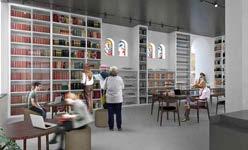
JHC Centre News 9
View of the grand foyer through to the Garden of the Pillars of Witness and the Eternal Flame.
Artist’s impression of the Memorial Room featuring a light well.
Artist’s impression of a learning space in the new museum.
Resource Centre incorporating the library.
“The need for the new centre is a wonderful endorsement of the work we do.”
Not with ink, but with blood and tears
 Genia Janover
Genia Janover
Yitzchak Meir Kluska came from a large traditional Jewish family in Jedrzejow, Poland. His occupation as furrier and tailor saved his and his younger brother Chaskel’s life when the Nazis occupied their town and they were assigned to forced labour. As the deportations which had already claimed their family continued, Yitzchak Meir and Chaskel went into hiding, entering a dug-out claustrophobic bunker which eventually harboured seven souls. During his two years in hiding, Yitzchak Meir kept a diary. This rare testimony, which captures the immediacy of his suffering, was recently donated to the Jewish Holocaust Centre by his daughter Genia Janover, and daughter-in-law, Judy Kluska, wife of Jack Kluska z”l.
Now within the Jewish Holocaust Centre (JHC) Collection, this precious diary describes the singular and collective suffering experienced by Jewish people under Nazi oppression. It also provides evidence against the cynicism of Holocaust deniers who seek to minimise victim numbers and diminish their suffering. As such, it transcends its personal and family signi cance, and is an important contribution to Holocaust history.

 -Dr Anna Hirsh, Senior Archivist
-Dr Anna Hirsh, Senior Archivist


10 JHC Centre News
A page from Yitzchak Meir Kluska’s diary. The published version of the diary.
Photo: Romy Moshinsky
Ein kurtser iberblik fun mayn leben, nisht als shrayber, vayl kh’hob tsu dem keyn talent vi oykh nisht genug lere. Nor mayne iberlebungen volt ikh gern gevolt zoln blaybn far mayn liber shvester vos is gikher zikher mitn lebn. Zi ge nt zikh in Rusland mitn libn man, vi oykh mit di libe kinderlekh. Zey zoln visn vos is geshen mit der gantser familye ven men hot zey umbgebregnt vi azoy. Dos is mayn tsil.
A short overview of my life, not as a writer, because as a writer I have no talent and not enough education. But my life story I would dearly wish to leave behind for my beloved sister who is more likely to survive. She is in Russia with her dear husband and children. They should know what has happened to our family and how they were annihilated. This is my aim.
So begins our father’s journal, now yellow and faded with the passage of seventy years. These memoirs were penned during 1943 and 1944 in Jedrzejow, as he hid in a bunker dug beneath a chimney, in the house of a neighbouring Pole.
Yitzchak Meir Kluska was an ordinary man – kind, intelligent, loving, and proudly Jewish – yet he had also lived an extraordinary life. To us, his children, he talked only of the present and of the future – nothing of the past. As my brother Jack and I grew older we knew somehow, almost by osmosis, that he had endured terrible suffering and loss. At some point, we even knew that there was a journal written during his darkest days. But he never spoke of it. It seemed that his mind, his heart, his very soul had a need for silence. And we never asked.
After our father passed away in January 1990, we shared memories and stories, and pulled out the precious few photographs that he had guarded. And we took out the journal that lay haphazardly and unceremoniously in the bottom drawer of his desk in a simple brown plastic folder labelled with his name.
For many months translation became the evening ritual for Mum, Uncle Chaskel, Jack and me. Yitzchak Meir’s beautiful, even script belied unbearable pain. His words spoke out poignant grief and empty days, the passion of bleak despair. His writing admitted us to his inner life, something that he had never really allowed us. We saw his youth, his energy, his creativity, his idealism, his modern outlook on life, his disagreements and his political activism.
We were warmed by the love that he expressed for his wife, the romance of their courtship and his unbridled joy at the arrival of a child, Regina, on 3 April 1937. We also ached for his loss.
I still run back for us to say our goodbyes and to hug and kiss my dear wife with tears and also my dearest daughter. She asked me a question: Daddy, where are you going? The question of my daughter echoes in my ears never to be forgotten. Daddy, where are you going? I can no longer answer her.
We ached for his harrowing sense of guilt.
I convict myself and accept a murderous sentence. I should not have listened. I should have gone with my people, to be killed with my wife and child, with parents and sisters – the whole family – not to have remained with a broken heart.
Wednesday 16 September 1942 was the last time my father saw his family. He, together with some 200 men left behind, was taken to a barracks from where they would be assigned to forced labour. Sometime after, he learned the fate of his wife and daughter, that they had been murdered soon after arriving at Treblinka.
On 18 February, 1943... I had a dream that my dear wife came from somewhere and told me that it is the time to leave the barrack, it is dangerous to still be here… [On] 20 February, 1943, I entered the bunker… How can ve men manage in this place?! This [bunker] is the foundation of the hearth of a replace. The width is two metres, the length is 1.8 metres and the height three metres.
As we translated, we became familiar with names: aunts, uncles, cousins, neighbours. Their names, in our father’s hand, their only memorial. We reproached ourselves that we had not asked questions. Perhaps Dad wanted us to ask? Perhaps he wanted to tell us directly. We translated as best we could, some segments we just left blank. We discussed donating the diary, but were unable to part with it. It was a physical conduit to our father. We placed it in a safe with other valuable items.
Almost 20 years later, I was asked to speak about an object that informed my identity. My brother and I retrieved the diary and we were shocked at its condition. The writing had faded, and the paper was disintegrating.
This compelled us to consider how to safeguard the diary for future generations. Together we commenced a project to conserve the pages and undertake a professional translation. We also made the decision to donate the original diary to the Jewish Holocaust Centre, where it would be expertly cared for and could contribute to a greater purpose. Our father’s journal belongs to the collective memory. This forms part of his legacy.
Our father lived another 45 years after emerging from the bunker at the end of the war. He responded heroically to the challenging Biblical summons: And thou shalt choose life. He was thankful for his new life, his happy second marriage to Regina, a survivor of the Skarzysko forced labour camp. He had his children and the children of his children to live for.
Not with ink rather with blood and tears, should be written the Jewish story. Who will write and what will be written will pale against the reality.
Our father, Yitzchak Meir Kluska, set himself an onerous task – to make known his story – dos is mayn tsil – this is my aim. It is our sacred duty to complete his task.

JHC Centre News 11
Yitzchak Meir Kluska (r-) with his parents Sara and Wolf and his brother Chaskel (l).
Survivors remember the Warsaw Ghetto Uprising

On the eve of Pesach 75 years ago, as the Jews of the Warsaw Ghetto conducted their Seders, the Pesach themes of freedom and slavery surely could not have been more pertinent. On 19 April 1943 – also Passover Eve –the Nazis were preparing to liquidate the Jews of the Warsaw Ghetto. With the vast majority of the Jews within the ghetto already having been sent to the Treblinka death camp or other concentration camps, the remaining Jews were not simply talking about freedom – they were doing so while living under the oppression of the Nazis.
To commemorate the 75th anniversary of the Warsaw Ghetto Uprising at the Jewish Holocaust Centre, we used the testimonies provided to the Centre’s Phillip Maisel Testimony Project to uncover what Melbourne Holocaust survivors witnessed. While these survivors were mostly children at the time of the uprising, and while their testimonies provide witness to the uprising, they also recall the conditions and daily life in the Warsaw Ghetto, beginning with its creation in 1939. Of course, as with any historical event, the survivors’ stories are each quite distinct, yet they also share certain aspects of the experience – including pain, suffering and luck.
Ella Prince (nee Zalcberg) was 13 years old when the ghetto was created. Ella provides testimony of the harrowing and tormenting
nature of the regular transports leaving from the ghetto, before which selections would take place and the chosen Jews would be sent to their deaths in Treblinka, or to further forced labour in concentration camps such as Majdanek. Ella notes, ‘It was always less and less people because the selections were more often.’ She witnessed this trauma personally, recollecting the day when her family was rounded up. She says, ‘The Germans from afar took away my brother from my father’s hand.’ They returned home that day ‘without my brother’. Only Ella and her mother survived the Holocaust.
Maria Lewitt (nee Markus) was 16 years old when she moved into the ghetto. Maria credits her mother with her own remarkable survival, as her mother believed that their options were either to ‘obey the Germans and then have their heads chopped off’, or ‘disobey them, do illegal things and risk having our heads chopped off’. Maria and her mother chose the latter, escaping from the ghetto in April 1941 and hiding on the Christian side of Warsaw with false papers, where her family continued to remain active in the underground resistance. She soon learned from the Polish Underground the ‘evil’ truth behind the transports from the ghetto, but says it was a reality that they ‘didn’t want to believe’. From outside the ghetto, Maria also provides a unique perspective in witnessing the Warsaw Ghetto uprising. Maria describes seeing the ghetto in flames as ‘like Atonement Day for us’.
12 JHC Centre News
Sam Brygel
Jews arrested during the Warsaw Ghetto Uprising as photographed by the Nazis
Abram Goldman was 15 years old when the ghetto was established. His account stands apart from the rest as he was directly involved in the uprising. Abram, together with his brothers, who also took part in the uprising, states, ‘We decided not to go to Lublin (Majdanek), we decided to go into hiding.’ Instead of going to the Umschlagplatz (assembly point for Jews prior to deportation), Abram and others ‘got some ammunition, guns and things, which the Poles used to supply, naturally for a lot of money’. Consequently, as Passover Eve and the imminent liquidation of the ghetto by the Nazis approached, Abram describes that ‘we were getting prepared to fight against the Germans’.

Henryk Strosberg was a mere nine years old when the ghetto was created. He offers the raw and emotional perspective of a small, frightened child. However, it is perhaps not fear that is the most pervading emotion for Henryk, but rather confusion in trying to comprehend the extent of the evil taking place in his hometown. He vividly vividly recalls the hunger and starvation that permeated the ghetto, especially remembering ‘children, starving, dying in the street, just being covered by newspapers, and taken away’. Another event that stands out for young Henryk is the suicide of Adam Czerniakow, head of the Jewish Council of the Warsaw Ghetto. Upon understanding from his mother that ‘this is a very bad sign’, Henryk was prompted to ask his mother, ‘Why was I even born at all?’ This comment is chilling for its rawness, for it perfectly depicts the confusion of a young boy thrown into an unreal world filled with evil and suffering.
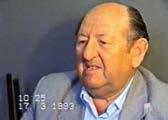
Halina Zylberman (nee Neuberg) was 14 when she moved to Warsaw in 1942. Like Maria, she also lived on the Christian side of Warsaw with false papers, and also offers a fascinating account. Referring to the cunning nature of the Nazis, Halina remembers that the ‘SS ordered them [the Jews] to sing… I thought it must not be so bad in the ghetto’. Later she realised this was part of their propaganda, pretending to the outside world that everything was fine in the ghetto. During the uprising and liquidation of the ghetto, Halina remembers the shameful

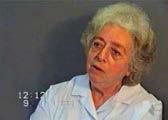
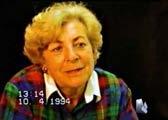
way in which the Polish children living nearby would play on the swings and ‘swing very high so they could see how the Jewish people were burning in the ghetto’. Moreover, Halina remembers how the children ‘were joking about it’.
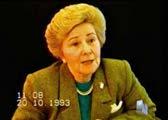
Lusia Haberfield (nee Hasman) was eight years old when the ghetto was created. For Lusia, worst of all was her memory of being at the Umschlagplatz awaiting transportation to concentration and labour camps. Lusia states, ‘If there is a hell, somewhere, at all, Umschlagplatz was the hell.’ She describes scenes of women being raped, and the suicides of women who refused to succumb to this horror. In doing so, Lusia provides a perspective that is often left out of Holocaust memory, yet it is a perspective that is necessary to understand the bottomless depths of the torment to which the Jews were subjected. When her testimony moves to the uprising, Lusia’s face lights up noticeably as she remembers seeing the brave fighters who were so young. Describing it as a ‘miracle’, she affirms that we should be ‘so proud’ of the uprising and its heroic fighters.
The Warsaw Ghetto Uprising is not remembered by Jews for its military victory, as such a reality was never even a possibility. Rather, it is remembered for the courage of the young people who, in holding out and fighting back for 27 days, ensured that it was the longest urban insurrection fought against the Nazis during the entire period of the Second World War. The uprising also inspired further uprisings in the Sobibor, Treblinka and Auschwitz concentration camps.
The remarkable oral testimony of the Melbourne Holocaust survivors who witnessed these events for themselves will ensure that the memory of the Warsaw Ghetto Uprising lives on forever.
JHC Centre News 13
(l-r) Henryk Strosberg, Lusia Haberfield, Maria Lewitt, Abram Goldman, Ella Prince, Halina Zylberman
Sam Brygel completed an internship at the JHC, working on this film project with the Curator, Jayne Josem, and Audio Visual Manager, Robbie Simons, as part of his Arts degree at Monash University.
Jewish life in Germany today
Mark Dreyfus
In July, the Jewish Holocaust Centre hosted the travelling exhibition ‘Jewish Life in Germany Today’. The exhibition was brought to Melbourne by the Embassy of the Federal Republic of Germany in Canberra.
In 25 poster panels, the exhibition combined the historical and contemporary aspects of living as a member of the Jewish community in Germany. In concise and striking statements, Jews explain what living in Germany means to them, how the history of the Holocaust influenced their personal lives and the dreams they have for their future in Germany. From students to best-selling authors, to rabbis and entrepreneurs, their biographies reflect the diversity of the German-Jewish community today and are a testament to the transformation that Germany has undergone since the Second World War.
The exhibition was opened by the Hon Mark Dreyfus QC MP. This is an edited version of his address.
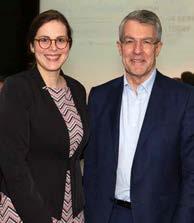
It is a pleasure to be here to launch this wonderful exhibition, and to have the opportunity to reflect a little about what this exhibition represents: a kind of Jewish renaissance in a nation that was a place of great importance to Jews, until the horrors of the Nazi regime and its aftermath cast a shroud of darkness over Jewish life there. Because what this exhibition makes so clear is how Jews and Jewish life is once again flourishing in Germany. And that is a wonderful thing to be able to say.
The story this exhibition tells is a story of importance to Jews the world over, and to very many, if not all, Germans. It is a story like so many in Jewish history that is about hope, about resilience and about renewal. And it is a story to which I have a very strong personal connection. It is my father, George Dreyfus, who should be giving this talk because he has had much more contact with Jewish life in Germany today than I have. I have visited Germany, but my father has returned there every year or two since about 1951. In doing so, he has participated in a very real way in making sure that there has been a renewed Jewish presence, including many performances of his compositions – including an opera or two – in Germany.
My father and his parents escaped from Nazi Germany, my father before the war, arriving in Australia with his brother, the late Richard, in July 1939. My father’s parents, my grandparents, arrived, some three months after the war started, in a somewhat miraculous escape from Germany. My great grandparents did not. They perished in the Holocaust.

14 JHC Centre News
Top right; (l-r) David Prince, the Hon Mark Dreyfus QC MP, Abram Goldberg OAM and the Hon Mark Dreyfus QC MP
Top left; Susanne Koerber and the Hon Mark Dreyfus
I have a continuing connection to Germany because all three of my children have taken up German citizenship, not because they have gone to live in Germany but because it is possible for children and other descendants of survivors to take up German citizenship, under a law of return that Germany has made possible.
I think we are all aware of the enormous contribution that German Jews have made to both Jewish and Western thought over the centuries. One could point to intellectuals like Moses Mendelssohn, Rabbi Abraham Geiger, Rabbi Samson Raphael Hirsch and Zacharias Frankel. All had a very significant impact on Jewish thinking and on our religious traditions. You could also point to German Jewish scientists in fields including physics, chemistry and medicine who have had a huge impact on the world, perhaps none more so than Albert Einstein. And in many other fields, as this exhibition reminds us with notes and images of Mayer Rothschild, Kurt Weill, Hannah Arendt, Max Liebermann and others.
Some of the statistics that are included in the exhibition tell the story of Jewish life in Germany with a stark simplicity. Around half a million Jews lived in Germany when the Nazis came to power in 1933. I will not dwell on this, the darkest chapter of Jewish history in Germany, other than to say around 300,000 Jews had left by 1939, a few thousand more managed to escape after the Second World War had started, but around 180,000 German Jews were murdered during the Holocaust, along with millions of others throughout Europe. The enormity of this crime, this loss, this horror, like so much of the Holocaust, can be stated, but not truly comprehended.
Yet the unspeakable enormity of that horror also underpins the remarkable story that this exhibition tells. And the fact that the Jewish community is once again thriving in Germany, still in living memory of the most appalling crimes against it, also speaks of the willingness of German society to confront the demons of its past. Because only by confronting the past has German society been able to make the heartfelt commitments needed to truly welcome Jews back into the German nation, and for Jews to trust that welcome.
At the beginning of the 1950s there were not more than 25,000 Jews living in the Federal Republic of Germany, and only a few hundred in the German Democratic Republic – at least only a few hundred willing to be identified as Jews to that German government. These figures did not change much over the coming decade, so that by 1990, there were still only around 30,000 Jews living in West Germany.
However, then things changed. Through the 1990s and the early 2000s, more than 200,000 Jews and their family members immigrated to Germany from the collapsing Soviet Union. Many were on their way to other nations but many stayed, so that now up to 200,000 Jews are living in Germany, with Berlin again the largest of those communities.
Indeed the Jewish community in Germany is now the eighth largest in the world and it continues to grow and flourish. I find it very heartening that thousands of young Israelis spend time in Germany – some for years – particularly in Berlin. And I also find it heartening that the state of Israel finds a loyal friend in the Federal Republic of Germany.
This exhibition provides a beautiful tapestry of how the flourishing Jewish community in Germany now looks. The diversity of the Jews that are represented tells us that there is a vibrant Jewish life in Germany today.

JHC Centre News 15
The Hon Mark Dreyfus QC MP is the Federal Member for Isaacs, Shadow Attorney-General and Shadow Minister for National Security.
(l-r) The Hon Mark Dreyfus QC MP and George Dreyfus AM
Failing to Understand Failure: Reassessing the Evian Conference of 1938
The Evian Conference took place in the resort town of Evian, France, between 6 and 15 July 1938. Formally named the ‘Intergovernmental Committee on Refugees from Germany (including Austria)’, it met at the invitation of US President Franklin D Roosevelt to discuss, in depth, the immigration policies of invited nations and their options for accepting refugees from Nazi Germany. The countries attending were not expected in any way to depart from their existing policies. When the meeting’s final recommendations were made no definite action was proposed – only that the deliberations should continue and a subsequent meeting should take place in London.
The major objective of this global conference was to do nothing. It was successful in achieving its fundamental aim of enabling an exchange of information among those attending, and nothing more. Contrary to what has become post-Holocaust popular wisdom, the delegates did not meet to open doors for refugee Jews, or force certain countries to ease their restrictions, or save Jews from the Holocaust. In 1938 there was, as yet, no Holocaust from which Jews needed saving.
There was, however, a refugee crisis and consequently, many nations were confronted with a situation that has many parallels with our own time.
Questions abounded: Should an opendoor policy be permitted for anyone claiming refugee status? Should quotas be imposed, and, if so, how are the decisions to be made as to numbers and eligibility? Should refugees be permitted entry on a short-term, long-term, or permanent basis? Should they be allowed in regardless of the prevailing economic situation? Should refugees of a different religious or ethnic background be given the opportunity to arrive? Should they be allowed to stay, thereby potentially transforming the existing social and/or ethnic fabric? The issues in 1938 (as today) were many, and the need to deal with them urgent.
An analysis of Roosevelt’s invitation reveals the following features: no particular ethnic, political or religious group
should be identified with the refugee problem or the calling of the conference; nothing should be done to interfere with the operations of existing relief bodies; all assistance for refugee work should be drawn from purely voluntary sources; and no nation should be required to amend its current immigration laws to accommodate the refugees.

The agenda would be set by the US government, and the conference would be dominated by three men: Myron Taylor from the United States, Edward Turnour (6th Earl Winterton) from Britain and Henry Bérenger from France. During their presentations, each stated essentially that they were far from prepared to do anything that would expand Jewish refugee immigration to their countries. The United States said there would be no expansion, only a merging of the existing German and Austrian quotas; Britain said that there would be no discussion of Palestine or the colonial Empire; and the French stated that they had already taken enough ‘aliens’ and were ‘saturated’.
This gave a lead to all the other countries, as they too made their presentations. Analysing the addresses made by delegates it becomes apparent that often they did not have prepared instructions from their governments, and they made things up on the spot. They acted safe in the knowledge that they were interpreting faithfully their governments’ views. This was therefore a gathering of representatives who projected a comprehensive perspective of official reactions to the refugee crisis. It is not a pretty picture. Grouping them into blocs, we see several themes for each.
The Europeans were concerned about the possibility of supplanting the League of Nations High Commission for Refugees. They expressed a preference that the United States and other countries outside Europe should begin accepting a greater share of the burden. The European countries were only were only prepared to accept refugees for temporary asylum in a short-term transit capacity and, although there was much sympathy, no country could play an active role in facilitating refugee resettlement.
16 JHC Centre News
Paul R Bartrop
“ “
The major objective of this global conference was to do nothing. It was successful in … enabling an exchange of information among those attending, and nothing more.
The Latin Americans, the largest group of states, were all keen to align with President Roosevelt’s call to link arms in a joint effort to ease refugee distress, and recognised that the refugee crisis was a humanitarian disaster. However, refugees would only be admitted in accordance with their existing laws; only those engaged in farming would be admitted; no special financial arrangements would be made to assist refugees; and any migration would have to proceed without any detriment to local workers. The Latin American states believed that the United States or the European nations should pick up the slack in solving the refugee issue. They also made it clear that urbandwelling professionals and intellectuals were not wanted.
The (self-governing) British dominions shared a sense of being able to take charge of their own affairs without interference from Britain, and stated that they had neither an interest in – nor a serious desire to help resolve – the refugee problem. Canada only wanted farmers; New Zealand did not want foreigners; Ireland, which had not originally been invited but went anyway, did not see itself as an immigrant-receiving country; South Africa did not attend; and Australia …?
Australia was represented by the Minister of Trade and Customs, Sir Thomas White, whose speech was largely the same as those of everyone else. He stated that ‘Australia has her own particular difficulties’. and that, were migration play any part in easing those difficulties, the only type that could be countenanced was British migration. Recognising ‘the unhappy plight’ of Jews in Germany
and Austria, White explained that ‘they have been included on a pro rata basis, which we venture to think is comparable with that of any other country’. He added that, ‘Under the circumstances, Australia cannot do more, [and] as we have no real racial problems, we are not desirous of importing one by encouraging any scheme of large-scale foreign migration’.
As no nation could foresee the Holocaust, the sense of humanitarian urgency was less pressing than it would become in later years. And therein lies a major element embedded within any assessment of the refugee problem in Europe prior to the outbreak of war in September 1939: every country in the world was formulating and administering an immigration or refugee policy – not a rescue-from-the-Holocaust policy. No one holding senior office during the 1930s, in any major state (including Nazi Germany), envisaged the Holocaust that would emerge within 18 months of the outbreak of war. Thus, when it came to addressing the situation at Evian, the only concrete proposal was to keep on talking, while at the same time not compromising the direction in which governments had already been heading.

Historians cannot see around corners, and no truer claim can be made than that our long distant past was, once upon a time, someone else’s far distant future. This is the same trap into which historians and other commentators have since fallen when looking at Evian. The refrain ‘they should have foreseen what was coming’ just does not work.
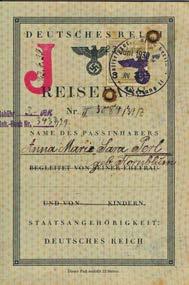
JHC Centre News 17
German Reich Passport issued to Anna Marie Sara Perl (nee Kornblum) in June 1939 and stamped with the letter ‘J’ to signify that the bearer is Jewish.
Lilo Nassau desperately walking with her son from embassy to embassy seeking immigration permits for her family after her husband was imprisoned in Sachsenhausen concentration camp.
Source: JHC, courtesy of Lilo Nassau
That said, there were a number of areas in which the Evian Conference, when measured against the standards of 1938, was clearly deficient. Even if the Holocaust could not have been foreseen, the possibility of war was evident, but at Evian there was no discussion of what would happen to the Jews of Eastern Europe should Germany embark on a war of conquest and thereby increase the number of Jews under Nazi rule. The conference never managed to resolve the points of crossover between the League of Nations High Commission, other refugee bodies and the conference, and it failed to suggest any sort of financial arrangements for the refugees. Nor, shamefully, did the delegates even agree to condemn the Nazi antisemitic persecution that led to the refugee crisis in the first place; in a climate of high appeasement, that issue was not even raised. These were all within the conference’s remit as targets that could have been met, but none ever was.
One person, however, saw through the conference rhetoric. At an official level, no one else, it seems, was as insightful as Adolf Hitler, who assessed Evian better than anyone else at the time. The Nazis realised that the conference was focused more on looking good than on actually doing anything of a definite and lasting nature, and saw that it was about saving the reputation of attending countries rather than Jews. In a speech at the Nazi Party rally at Nuremberg on 12 September 1938, Hitler made explicit the connection between Roosevelt’s calling of the conference and his attempt to deflect attention away from an otherwise unhelpful American policy.
One final, key question needs to be asked: could the Evian Conference have made a difference to the events that were to follow? The best answer is only … perhaps. Evian could have acted as an occasion for caring administrations to voluntarily agree to increasing their refugee or immigration intakes. However, questions of realpolitik, racial and population preferences, antisemitism, economic priorities and other factors led to a collective rejection of any liberalisation in favour of Nazi Germany’s unwanted Jews. No other outcome was ever likely, and the hopes of many were consequently misplaced and unrealisable.
Therefore, is it legitimate to refer to Evian, as many have done in light of the Holocaust, as a ‘failed’ conference? I do not think so. After all, it lived up to the terms of Roosevelt’s original invitation and, as a result, delegates stated that their countries were actually doing quite a lot for refugees, while at the same time demonstrating that they could do no more and were not prepared to try. In what was a classic case of ‘virtue signalling’, the assembled countries used the opportunity to look good, but the refugees gained nothing.
It is perhaps no coincidence that the word Evian, when spelled backwards, reads ‘naive’, for that is precisely what the conference was. A cynical attempt to deflect attention from otherwise unhelpful policies on a global scale, for the Jews of Germany and Austria – and in the public consciousness ever since – the stakes for the Jews of Germany (and then Europe) were frighteningly high, confronting a regime that cared nothing for the standard conventions of international behavior and a community of states that cared little for the fate of the people they had come together to discuss. If there was any failure, it was a failure of imagination – both on the part of the countries attending and those hoping that some other outcome would be possible. Evian must be viewed through the lens of its initiation in March 1938, rather than the horrors of the Second World War and the Holocaust.
It is therefore heartbreaking that ever since Evian there has been a constant narrative that begins with the words ‘the failure of the Evian Conference’. Yet if its failure lay in the fact that the delegates did not foresee Auschwitz, they were not alone. No one in 1938 could have done so; more is the pity.
After Evian, but prior to the German attack on Poland precipitating the outbreak of war, many events further reduced options for the Jews of Germany. These included the establishment of a Nazi Office of Jewish Emigration to speed up the pace of Jewish emigration from Germany (1 August 1938); the requirement that Jewish women add ‘Sarah’ and men add ‘Israel’ to their names on all legal documents (17 August); the closure of Swiss borders for Austrian Jews seeking sanctuary (19 August); the Munich Agreement in which Britain and France surrendered the Sudetenland regions of Czechoslovakia to Germany by negotiation (29–30 September); the compulsory stamping of passports belonging to German Jews with the letter ‘J’ to indicate their identity (5 October); the Kristallnacht pogrom throughout Germany and Austria (9–10 November); the German invasion of what remained of Czechoslovakia (15 March); and the return to Europe of the SS St Louis , a ship carrying 936 Jewish passengers, after being denied entry into Cuba and the United States (17 June). Germany invaded Poland on 1 September 1939; Britain and France declared war on Germany two days later.
While it is true that before Evian there were no mass deportations or large-scale brutal assaults against Jews, it is equally true that these began in increasing measure after Evian. Were these in response to the nations of the world turning their back on the Jews in July 1938? Ascribing too much to a Nazi grand plan leading to the Holocaust is dangerous; as stated earlier, no
18 JHC Centre News
“ “
At an official level, no one else, it seems, was as insightful as Adolf Hitler, who assessed Evian better than anyone else at the time. The Nazis realised that the conference was focused more on looking good than on actually doing anything of a definite and lasting nature …
Arrival of Polish Jewish refugees in London, February 1939

Australian landing permit for Herbert and Ilse Lippman dated 28 November 1938

one at Evian could anticipate what would happen next, and Nazi policies did not foresee the events to follow. There could be no escaping the fact, however, that even in July 1938 the Jews of Germany were in desperate straits, or that the states represented at Evian displayed little other than apathy and disregard over their ultimate destiny.
The years following Evian should have broadened humanity’s horizons. How far that rings true today is for another generation to judge, but considering Evian they will have a template upon which to rest their considerations.
Two quotes exemplify the relevance of the Evian Conference for the present: Rabbi Hugo Gryn, a Holocaust survivor who became one of the leading spiritual leaders in the United Kingdom wrote in his memoir, ‘Time is short and the task is urgent. Evil is real. So is good. There is a choice.’ And Elie Wiesel stated, ‘The opposite of love is not hate, it’s indifference. The opposite of beauty is not ugliness, it’s indifference. The opposite of faith is not heresy, it’s indifference. And the opposite of life is not death, but indifference between life and death.’
This is an edited version of a public lecture presented by Professor Paul R Bartrop at the Jewish Holocaust Centre (JHC). Professor Bartrop is Professor of History and Director of the Center for Judaic, Holocaust and Genocide Studies at Florida Gulf Coast University, Fort Myers, Florida, United States. He is currently a Visiting Fellow at the JHC.
JHC Centre News 19
Source: Bundesarchiv, Bild 183-S69279 / CC-BY-SA 3.0
Anita Selzer
in conversation with Lisa Phillips
Anita Selzer is a Melbourne-based author who writes non-fiction for children and adults. Her book, titled I Am Sasha, was published recently. Here she is in conversation about the book with Lisa Phillips, the Jewish Holocaust Centre Education Director.

LP: Why did you decide to write this story?
AS: In 1994, before my grandmother passed away, she handed me a manila folder with Ioose Ieaf pages in it. In it she wrote, ‘The story of how your father and I survived the Holocaust is in this file. I want you to tell the world how we did. You are becoming a writer with a book already published. Please write and publish our story. Promise me.’ I wrote I am Sasha to honour her wish and leave my children a tangible record of their legacy. I would not have thought to write the story if she had not asked me. It was a part of my father’s life that he really did not want to discuss.
LP: You had your grandmother Larissa’s memoir and a short story written by your father. Could you tell us about what they contained, when they were written, and what other research you had to do to write I Am Sasha?
AS: The pages in Larissa’s memoir were written in blue biro, spanning the years of her life. While her mother tongue was Polish, the memoir was written in English, in post-war Melbourne. It focused on her family life, meeting and marrying my grandfather, losing him, and life during the war and postwar years.
In Melbourne in 1966, my father had typed a short piece about his life during the war entitled ‘A Magnificent Deception’. lt begins in 1941, describes various incidents that are recorded in my grandmother’s memoir, and mentions how he had survived disguised as a teenage girl. Dad had submitted this story for publication without success. I think the time was not right then, and his rendition did not include how he had felt or thought about being a teenage girl. What his writing told me, however, was that Dad wanted his story shared with a wider audience.
As I wanted readers to feel as if they were there on the journey with Sasha and Larissa, I had to do extensive research, so I gathered information about pre-war Poland, the Second World War, the Holocaust, other survivors’ experiences, and the places in which my father and grandmother had lived and visited.
20 JHC Centre News
(l-r) Anita Selzer and Lisa Phillips
LP: The historical detail is a strength of the book, which makes it an excellent educational resource. You describe the rich Jewish world that existed before the war; the death camps, which you refer to by name; the mobile Einsatzgruppen and their role in the destruction of the communities; the Jewish councils known as the Judenrat; the Warsaw Ghetto Uprising whose 75th anniversary we have recently marked; and you even had Sasha reading Janusz Korczak’s books for children. How did you decide what information to include and what to exclude?
AS: Initially, it was daunting to decide what information to include and exclude in the book. I wanted to write more than the story of my family’s survival, so it was important to include the historical context. I felt the need to paint the bigger picture of war and educate readers about it, especially for young adult readers, and adults who may not know much or anything about the Holocaust.
I wished there to be shades of light and dark in the book, to show love, kindness and hope, as well as the horror of war. Other themes in the text are racial and religious identity; gender identity; adolescence and puberty; racism, inhumanity and human rights; truth and deception; hiding; choice and chance; friendship and trust; cruelty; tolerance and acceptance; loss and displacement; and immigration. There are probably more themes woven through the text that I hope readers will enjoy discovering.
I wrote hoping that readers would have a visual experience –that they are able to see the story unfolding through the text. Above all, for me, I Am Sasha needed to be as authentic as possible. The memoir and photographs are primary sources
–historical evidence that authenticates both the story and moments in history. That is why I included excerpts from the memoir along with photographs. Sasha reading a book like Janusz Korczak’s work was also a conscious choice to include as an example of what was read by young people at that time.
I chose to exclude some historical information in telling the story of Sasha’s survival, Larissa’s early family life and her life with her husband, as I felt the focus needed to be on Sasha and his journey. That is why I wove the history seamlessly into the story, rather than having it stand out as a history lesson. I also felt that the text would have been too long had I written more detail about the war.
LP: What were some of the challenges you faced when writing I Am Sasha?
First, writing in the voice of a young boy who is telling a story was challenging, as I had not done this before. My preceding nine published books were in the area of Australian history and biography. Imagining Sasha’s feelings and thoughts was a second challenge, as I had never discussed these with my father. He did not talk about the war, only to say, ‘Every day I got after the war was a bonus because I was destined to die.’ I needed to imagine his thoughts and feelings. Perhaps raising two sons enlightened me somewhat about the psyche of an adolescent boy. And thirdly, finding the right publisher and ‘home’ for I am Sasha was a long road, which required faith and perseverance.
Originally, I wrote Saving Sasha in my grandmother Larissa’s voice in 2013. That was challenging because I had never written a novel before. A year later, I submitted the manuscript to publishers. Although there was considerable interest, I was not convinced that the offers made to me were the right ones, so at that stage I felt disheartened. Eventually, however, I was advised to re-write the story in Sasha’s voice and tell the story from his point of view. I did this with reluctance, but it was the right strategy, as the new manuscript was accepted by Penguin Books. I felt I had now found the right home for I Am Sasha, as the publishers understood the emotional resonance of the story.
LP: What m essages would you like those reading I Am Sasha to gain?
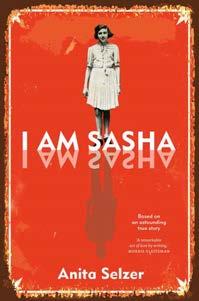
AS: Toler ance and acceptance of different races and cultures is an important message, along with the promotion of global peace, love and kindness. We need to remember that we are all the same, made of flesh, blood and bone. We also need to reflect and recall the inhumanity of Adolf Hitler and his regime and say ‘never again’.
I would like readers of I Am Sasha to understand that gender is not necessarily fixed, but rather can be fluid, enacted, practised and contested. Gender is part of a becoming and, to a large extent, a performance. As existential philosopher Simone de Beauvoir has said, ‘One is not born, but rather becomes a woman.’ And this is influenced by choice – like the reluctant, but lifesaving one made by Sasha as a teenager in I Am Sasha.
JHC Centre News 21
Jewish Rescuer Citation awarded to Ronia


Rozental
In April 2018, the late Ronia (Rone) Rozental was awarded the Jewish Rescuer Citation. The B’nai B’rith World Center in Jerusalem and the Committee to Recognize the Heroism of Jews who Rescued Fellow Jews During the Holocaust (JRJ). created the Jewish Rescuer Citation in 2011 to honour Jews who rescued other Jews, and to highlight Jewish resistance during the Holocaust. To date, almost 200 rescuers have been recognised. They were active in France, Hungary, Greece, Germany, Slovakia, Yugoslavia, Poland, Ukraine, Italy, Latvia, Austria and Holland, and all put their own lives in jeopardy to help other Jews under Nazi rule. Ronia Rozental was the rst Jewish rescuer from Lithuania to be awarded the Jewish Rescuer Citation. She had been previously awarded the Saviour Cross by the Lithuanian Government in 1993 – the only Jew to have received that honour.
Ronia and Shmuel Rozental lived in Kovno (now Kaunas) with their son Leo before the Nazi occupation. Shmuel was the principal of the Shalom Aleichem School and Ronia was the director of the kindergarten teachers’ training college. Some of her students were nuns.
The Rozentals, together with all the Jews of Kovno, were forced to move to the Kovno Ghetto in June 1941. Ronia and Shmuel’s daughter Rona (now Rona Zinger) was born in the ghetto in 1943. As the Nazis had issued an order making pregnancy illegal for Jewish women, Ronia had to conceal her pregnancy, and after Rona was born, Shmuel created a special hiding place in which to hide her and her cousin Lusi, who was also born in the ghetto.
Although education for Jewish children was banned in 1942, Shmuel taught in the Yiddish underground school established in the ghetto, and he also forged identity documents. Ronia’s role in the underground organisation was to rescue Jewish children. She used her pre-war contacts with student nuns to arrange hiding places for children in a monastery, an orphanage, and with Christian families. With her green eyes and dyed blonde hair, she looked Aryan and came in and out of the ghetto without wearing the yellow Star of David that was mandatory for all Jews.
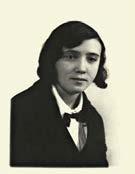
In 1943, Shmuel smuggled Leo out of the ghetto in a sack of potatoes and he was hidden in a tiny space under a stove by a poor farming family. Rona was also smuggled out of the ghetto and hidden by a gentile couple. Baptised and named Lily, she lived with her foster parents until she was six. Shmuel, Leo and Rona survived the war, but Ronia was murdered in Stutthof Concentration Camp. Shmuel was liberated from Dachau Concentration Camp and was nally reunited with his daughter in 1949, when he renamed her Rona, after her mother.
Ronia Rozental’s award in recognition of her actions in rescuing Jews during the Holocaust was presented during a moving Yom Hashoah ceremony at the Gvillei Esh (Scrolls of Fire) Square in the Forest of Kdoshim (Martyrs Forest), Israel. The medal was accepted by her granddaughter, Maya Rozental.
22 JHC Centre News
Jewish Rescuer Citation awarded to Ronia Rozental
Ronia Rozental, Kovno 1936
Maya Rozental (front row 2nd right) with Ronia Rozental’s Jewish Rescuer Citation
Lowicz: a city sentenced to death
Michaela Glass
My grandfather, Zigmund Glass, was born in Lowicz, Poland in the early 1920s. In 1939 he ed to escape the Nazis with two of his three brothers, Jerzy and Marek. They travelled from Russia to Japan and then sailed to Canada. In Canada, Zigmund and Marek enlisted in the Air Force. Like many other Polish refugees, they were sent to England join the RAF. Both brothers served in the Bomber Command during the Second World War. Marek was killed in battle. Zigmund survived and ultimately settled in Inverness, Scotland, where he married Doreen Gordon.
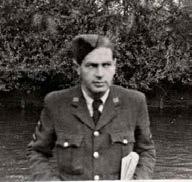
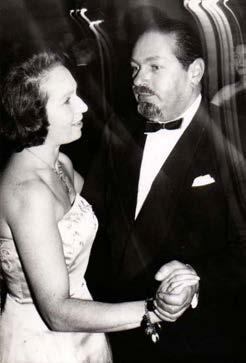
This is the story of my grandfather’s hometown. Lowicz is half way between Lodz and Warsaw. Jews had lived there since the 14th century. Before the Shoah, Lowicz was a sleepy town. It came alive with peasants from the surrounding villages on market days.
Lowicz had a synagogue and a kehillah. The Jewish community opened a public Jewish library in 1906. After the First World War, one quarter of Lowicz’s population was Jewish. The Jews worked mostly as artisans or academics.
The Lowicz Jews were diverse. There were intellectual, Zionist and Socialist groups, as well as an active youth movement. Lowicz was one of a few small towns even to have its own Yiddish weekly, the Mazowsher Wochenblatt.
Throughout the ages, Lowicz had been protected by the Bzura River. The river wrapped around the city, creating two islands. These were used as defensive outposts to keep the city safe. Until the Nazis came.
On 1 September 1939, seven Nazi planes bombed Lowicz from the air. The Nazis quickly occupied the city, and burned down the synagogue which had been the pride of the Jewish community since 1887. Their next project was to destroy the Bzura River.
The Nazis ordered the Jews to create walls in the river, redirecting the water away from the city. This would make it easy for German armies to enter on foot. They never wanted Lowicz to be a Jewish ‘fortress’ again.
The Lowicz Jews thought that working for the Nazis would spare them their lives. They had no idea that by diverting the river they were eliminating any chance their community had of surviving.
The Nazis established the Lowicz Ghetto, the rst in the Warsaw district. They also created a Ghetto Police who would ensure a constant supply of workers. Three hundred Jewish slave labourers were sent to build the river walls daily. These merchants and members of the Jewish intelligentsia had no experience of
physical labour. They were fed small bread rations and thin soup in exchange for their work.
Survivor Gedaliah Tcharneson-Shaiak said, ‘They died like ies, weakened, famished and exhausted.’ Nazi soldiers ordered the workers to use thousands of Jewish tombstones to strengthen the wall. In four months, they built a wall six metres high and 10 kilometres long.
With their ancestors’ tombstones under water, their synagogue burnt down and their population starved, the Lowicz Jewish community had been spiritually and physically destroyed. The Lowicz Ghetto was liquidated in 1941. During the Shoah, 18,000 Lowicz Jews were murdered. Many members of this once-thriving community had even been forced to dig their own graves.
Michaela Glass is a journalism student at Monash University and the granddaughter of a Holocaust survivor. She was the 2018 recipient of the Irene and Ignace Rozental Internship and interned at the Jewish Holocaust Centre in July 2018. She is researching survivor testimony, focusing on the experience of Polish Jews during the Shoah.
JHC Centre News 23
Zigmund and Doreen Glass
Zigmund Glass in his RAF uniform
My Holocaust memorial year abroad at the Jewish Holocaust Centre

As a young Austrian, one has to choose between two types of conscription: Armed Forces or Civil Service. Few know about the third possibility of doing Memorial Service abroad. For me, however, it was immediately clear that this would be my choice. After doing some research, I chose the Jewish Holocaust Centre (JHC) as it is one of the last Holocaust memorial institutions where one can still actively work with survivors of the Holocaust, and I am part of the last generation who can sit with survivors and listen to their stories. Despite the enormous amount of preparation involved and the demanding project in which I was involved, I would never have wanted to miss the experience I have had.
When I rst arrived, I was introduced to JHC employees, volunteers and survivors, and attended school programs during which survivors spoke to students. My rst projects were working with the audio/video producer and curatorial department to create online portfolios on the video platform Vimeo, to be used for marketing. I also help install a new video camera system in the JHC large auditorium to simplify the process of lming events.
In the archives department I learnt about the cataloguing and archiving of documents and artworks. I also translated documents from German to English, ranging from a 40-page account written by a Holocaust survivor to the documents in the Marcuse collection. Ernest Marcuse was a Berlin artist of Jewish descent who immigrated to Australia shortly before the war, and the collection includes numerous technical drawings, many of which are amazingly futuristic.
As I have training as an event technician, I participated in the planning and staging of events. My role involved photographing and lming events, as well as ensuring that the sound and set-up of the facility were appropriate.
I took part in the Hide and Seek education program by helping students with the correct pronunciation of German names and addresses, as well as ensuring that the program ran to schedule. I was also involved in the digitising of comments left by students on a noticeboard at the end of their visit, so that this valuable feedback can reach a wider audience.
By far the most demanding and time-consuming project in which I was involved was the compilation of an inventory of the entire JHC, in preparation for the Centre’s redevelopment. My task was to count, label and list every single item in every room so that items can be packed and moved. I was also entrusted with
administrative tasks, including answering telephones, shopping for supplies and doing simple repair work.
It was a great honour to represent the Austrian Ambassador at a prestigious event, but the most important and memorable part of my time at the JHC was my daily interaction with Holocaust survivors, and the lifelong memories I will have as a result.
Now that my 10-month placement is over, I have absolutely no regret about my decision to complete my Memorial Service at the JHC, and I am sure that the experiences I have had and skills I have learned will be of great help in my future working life. I thank my colleagues, and the volunteers and survivors for their help and support.
24 JHC Centre News
Julius Sevcik
Julius Sevcik
Hope for a better future
In June, author and journalist Julie Szego launched Hope for a Better Future, by Sarah Saaroni OAM. This memoir is a sequel to Sarah’s autobiography Life Goes on Regardless... (Hudson Publishing, 1989), which focused on her childhood in Lublin, Poland, her story of survival during the Holocaust and her journey rst to Palestine (now Israel) and then to Australia.
The sequel takes the reader on Sarah’s life journey after the Holocaust. Sarah’s personal victories in Israel were overshadowed by ongoing nightmares triggered by the Holocaust and the hardships of daily life. Uprooted yet again and resettling
in Australia, Sarah quickly discovered that even in a nation of peace and prosperity life was not without its vicissitudes. However, she discovered catharsis from her Holocaust trauma through creative expression, family and involvement in the Jewish Holocaust Centre.
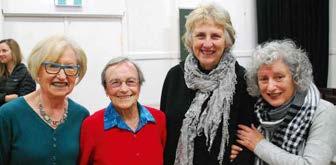

Sarah Saaroni’s memoir is a story of courage, determination and resilience. It is available at the Jewish Holocaust Centre, email admin@jhc.org.au or phone (03) 9528 1985.
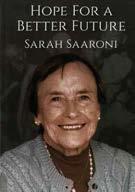
Phillip
Maisel
Testimonies Project
The Jewish Holocaust Centre has over 1,300 video testimonies as well as over 200 audio testimonies in its collection. These provide eyewitness accounts of the horrors of the Holocaust, as well as glimpses into the vibrancy of pre-war Jewish life in Europe. The collection is widely used by researchers and students of oral history, the Holocaust and a variety of other disciplines.
If you would like to give your testimony or know of someone who is interested in giving a testimony, contact Phillip Maisel. Phone (03) 9528 1985 or email testimonies@jhc.org.au.
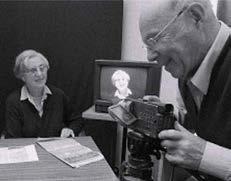
JHC Centre News 25
(l-r) Tosca Mooseek, Sarah Saaroni OAM, Dorothy Saaroni and Rae Silverstein
(l-r) Maria Lewitt OAM and Sarah Saaroni OAM
Keeping their memories alive
Vivienne Dacey
Twelve thousand people participated in this year’s March of the Living (MOTL) and our international group comprised 45 Australians and 45 others from around the world. Going on MOTL was a decision I made without too much hesitation. I had been to Poland many years ago, so I knew that what I was going to see would be difficult, but I did not anticipate the impact it would have.
My parents were both Holocaust survivors from Poland, so the Holocaust has always been a part of my life. We did not talk about the Holocaust all the time, but it was just always there, always a silent part of the conversation. Every movie, book or article written about the Holocaust was quickly devoured. My parents’ friends mostly had similar backgrounds, so they all spoke the same language. More so than their spoken tongue of Polish, the language of their experiences connected them. Most of them are gone now, but these memories have loomed larger since my trip.
I felt my parents with me in Poland and could hear their voices talking to me everywhere we went. When I looked at the menus with those familiar choices – kielbasa, pierogi, golabki – my mother’s voice was telling me that they were never as good as hers. And my father’s – speaking incredulously about how much they charged for such a small portion! Those memories warmed my heart and made me giggle.
I found myself walking down the streets of Warsaw imagining my parents with me. If not for the war, my sister and I would have been born and raised there. We would have been educated in their schools, married and had another generation to follow the many that came before. I found my great grandparents’ graves when we visited the Warsaw cemetery, still intact though showing the damage of time. Many in our group felt that all of Poland was a graveyard, but I felt that part of me belonged there. I still yearn for the family I never met, the family I can never know. This sense of overwhelming loss really rocked me.
While walking through the exhibition in Block 27 at Auschwitz, I saw the Book of Names listing more than four million individuals who were murdered. Finding hundreds of names from both my mother’s and father’s families, I broke down inconsolably. It was overwhelming to be suddenly presented with the reality of my tiny family against what it might have been. Having this evidence thrust so menacingly at me in a book of more than 8,000 pages was difficult to digest. The enormity of the loss became even more personal and was suddenly all I could think about.
Standing in front of the incredible POLIN museum, on the site of the former Warsaw Ghetto, I gave my mother’s testimony. I felt her standing with me as I shared some of what she endured in the ghetto in those horrifying times. I could have been standing metres from where she quickly composed herself to grab her sister and hide in a building as the Nazis rounded everyone up to go to the trains. She used her intelligence and intuition to deal with the impossible challenges of her everyday reality. She was a mere 12 or 13 years of age, a girl whose childhood was ripped from her in the most brutal of ways. And yet, she survived. It took all my strength not to break down before finishing her story. I felt the warmth and caring of the 90 or so people listening intently to my words. My mother was the embodiment of strength and resilience and an incredible force in my life, and she was with me as I brought her memory to life.
What was different about this trip to Poland was that I was immersed in a program that prepares you before you go, supports you during the march and continues long after you return home. It is particularly important that the MOTL program provides this continued support as more of us mourn our parents’ passing. It now falls to us, the next generation, to carry their stories and keep their memories alive. Never again!

26 JHC Centre News
Vivienne Dacey is a member of the MOTL Committee of Management. She was a participant in the 2018 MOTL program.
extracts from my MOtl jour nal
At M A jdA nek
Icould feel my eyes burning while walking through the gas chambers. I do not know whether it was from lack of sleep, or if the remains of the Zyklon B gas used by the Nazis are still present. Either way I, couldn’t even begin to think about the number of Jews that passed through those rooms. It could have been me, it could have been my friends, it could have been my family.
There was a window, but no light entered. Apart from me, the only sign of life was a butterfly trying to escape. There’s a poem written by children while they were living in Theresienstadt Concentration Camp about never seeing another butterfly. At Majdanek, I was seeing that butterfly, and it seemed as if it was flying for those who couldn’t. It reminded me of why this trip is called ‘March of the Living’; it is because we are living – living for those who cannot.
Seeing the little peephole that was used to oversee the gassing was incredibly confronting. That someone could stand there and watch the deaths of so many people, have the ability to prevent those deaths, but doing nothing and allow it to happen. I just can’t comprehend the sheer number of people who walked in here and never left.
In the crematorium, I saw another butterfly. There was light in this room, and windows, which almost made it worse as it was so easy for people to see what was going on. The butterfly reminded me that so many people didn’t even make it to that room alive.
Finally, seeing the ashes in the huge pit at the Majdanek Mausoleum really affected me. The ashes of only a tiny proportion of those murdered were here in front of me. I walked around the entire memorial just thinking and thinking about all those people. Others were there taking photos. It seemed disrespectful but, looking back, I can see that photos are important, even necessary, to educate others so that they cannot deny the Holocaust.
All 17 of our group, plus the cohort from New Zealand, formed a circle, linked arms and sang ‘Acheinu’ and ‘Hatikva’. I felt hurt,

sadness and anger, but also empowerment. I cried so much that I couldn’t even sing those two meaningful songs about unity, and hope. It was difficult to sing about optimism and brotherhood in a place where those who had hoped to survive had died, together with their brothers and sisters.
Many black crows and butterflies are drawn to the camp. Crows are a sign of death, and a shadow of the life that was lived there. Butterflies are a symbol of life and freedom. Adjacent the ‘Jewish cemetery’ of Majdanek is a Christian cemetery. It is such a contrast that in one, people died naturally and were buried respectfully, and in the other, people were murdered, shot, gassed and burnt, and not even buried.
In Isr A el
Coming to Israel after the week we had in Poland is something that not many people will ever experience. Poland was a place where Jews were denied the practice and celebration of their religion, and were persecuted solely for being Jewish. In contrast, Israel is a place that celebrates Judaism. Every city is filled with all kinds of people who observe Judaism in their own unique way. The streets are lined with Israeli flags, the buildings built with Jerusalem stone, and Hebrew, the language of Am Yisrael, is spoken everywhere.
After leaving Poland, and flying to Israel, I can now fully appreciate how lucky we really are that Israel exists. I have been to Israel many times before, but this trip has been the most meaningful. By witnessing what happened in Europe during the Holocaust, our lowest of lows, it helps you value that that Israel is flourishing, and that we have so many opportunities to practise and celebrate Judaism freely.
JHC Centre News 27
Michaela rait man is a student at Leibler Yavneh College who participated in the 2018 Student MOTL program.
Michaela Raitman
Photo: Emmanuel Santos
JHC Social Club
Barbara Sacks
Holocaust survivors, volunteers and guides, together with their friends, meet monthly at the Jewish Holocaust Centre (JHC) Social Club. The Club continues to attract stimulating and informative speakers, and participants take part in lively discussion after each presentation.
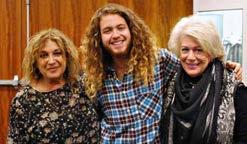

Over the past few months, the Social Club has addressed a variety of thought-provoking subjects. George Golvan QC is the child of Holocaust survivors and a barrister who has been an active litigator, mediator, arbitrator and board chairperson. He spoke to us, however, about ‘Iran – Off The Beaten Track’, describing his journey through this fascinating country, illustrated with wonderful photos.
Writer, painter and the daughter of Baghdadi Jews, Nita Tiffaha Jawary presented a lecture about ‘The Farhud’ (The Anarchy), a cataclysmic but often-overlooked subject. Nazi antisemitism was rife in the Middle East during the Second World War and, in Iraq, antisemitic violence culminated in the massive attack against Jews in Baghdad in June 1941 known as ‘The Farhud’.
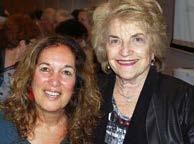
Eglal Ali, from the Nuba Mountains Community Association of Victoria, joined Lisa Buchner from Stand Up to discuss Eglal’s amazing journey from Dilling, a small town in the Nuba Mountains in Sudan, to Australia. Arriving in Australia in 2005, and having worked in a clothing factory in Sudan, she now works in aged care and is a leader of her community association.

Writer Heather Morris, who had previously written screenplays, was introduced to an elderly gentleman she was told ‘might just have a story worth telling’. That meeting with Lale Sokolov proved to be life changing for both. It resulted in Heather writing a screenplay about Lale’s story and then reshaping it into her debut novel, The Tattooist of Auschwitz, which was the thought-provoking subject of her address.
Nevo Zisin is a Jewish, queer, non-binary activist and public speaker, and the author of the newly released memoir Finding Nevo, a memoir on gender transition. Nevo has run workshops in schools and workplaces around gender inclusivity, and is a contact point in the Jewish community for others dealing with issues of gender and sexuality in their own lives. Nevo spoke to us on the topic of ‘Living My Truth’, raising some confronting but important issues.
Physician and award-winning writer, Leah Kaminsky, presented a lecture titled ‘Bearing Witness through Fiction’. The author of fiction and non-fiction, her debut novel, The Waiting Room, addresses issues of memory, love and loss, and the insights she shared resulted in spirited questions and discussion.
The JHC Social Club attracts between 45 and 60 people regularly, and welcomes members of the community to attend for bagels and coffee, and for stimulating and lively discussion. The Club meets monthly on Thursday mornings at the Jewish Holocaust Centre.
For further information about the JHC Social Club, please contact Barbara Sacks on 0404 224 498.
28 JHC Centre News
(l-r) Barbara Sacks, Annetta Able, Lisa Buchner, Eglal Ali and Stephanie Heller
(l-r) Nita Jawary and Barbara Sacks
(l-r) Adele Pakula, Nevo Zisin and Lyn Samuels
(l-r) Cesia Goldberg and Heather Morris
Young Friends of the Jewish Holocaust Centre
The evening after Yom Hashoah (Holocaust Remembrance Day) in April, 250 young adults gathered to attend a commemoration ceremony at the Jewish Holocaust Centre. Designed to engage the younger generation, we shared poems, sang songs and heard Holocaust survivor Irma Hanner’s inspiring story.
In June, the Young Friends of the Jewish Holocaust Centre held a film night at the Classic Cinema. Fifty young adults watched Run Boy Run, a German-Polish-French co-production about an eight-year-old Jewish boy who escaped from the Warsaw Ghetto in 1942 and survived for the next three years, largely on his own, in rural Poland. This moving film provided valuable insights into the events of the Shoah.
Through involving young people in our functions and in the work of the Jewish Holocaust Centre, the committee of the Young Friends of the Jewish Holocaust Centre aims to keep the memory of the Holocaust alive, and to remind the younger generation of our important role in carrying on the legacy of Holocaust survivors.
If you are between the ages of 18 and 25, we hope you can come to our functions. We also welcome new members to our committee. For further information about the Young Friends of the Jewish Holocaust Centre, please contact Bianca Saltzman on 0412 988 752, or email biancas1996@hotmail.com.
Become a Friend of the Jewish Holocaust Centre & support the activities of the Centre.

The Friends of the Jewish Holocaust Centre plays an important role in providing financial support to the Centre through membership subscriptions, raffle book sales, sales of the Entertainment Book and social fundraising functions.
To become a Friend of the Jewish Holocaust Centre, simply download and complete the form from jhc.org.au.
For further information please contact Elly Brooks on (03) 9528 1985 or email ellyhbrooks@gmail.com.
JHC Centre News 29
(l-r) Elly Brooks, Irma Hanner and Bianca Saltzman
Bianca Saltzman
Seen around the centre

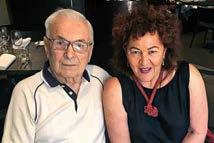
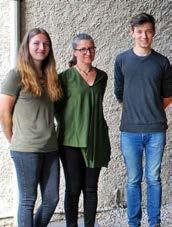
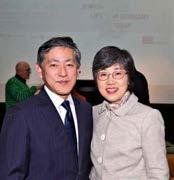
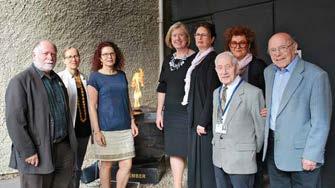
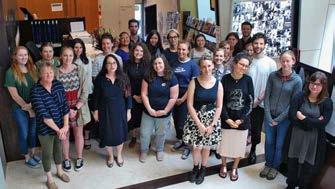
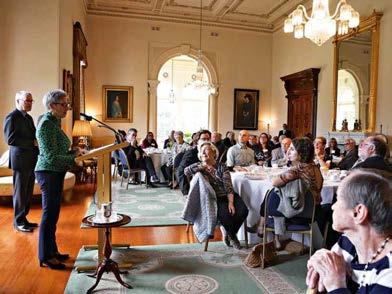
30 JHC Centre News
➊ ➋ ➌ ➐ ➏ ➍ ➎
➊ The Hon Linda Dessau AC with Holocaust survivors and their families. Photo: Joe Lewitt
➋ (l-r) Warren Fineberg, Jayne Josem, Sue Hampel OAM, Lynette Wood, Dr Donna-Lee Frieze, Abram Goldberg OAM, Pauline Rockman OAM and Phillip Maisel OAM
➌ Master of Cultural Materials Conservation students with Dr Anna Hirsh (front 3rd left)
➍ Kazuyoshi Matsunaga and Yoko Matsunaga
➎ (l-r) Magdalena Fröschl, Veronika Sevcik and Julius Sevcik
➏ (l-r) Jayne Josem, Dorothy Josem, Tara Josem (seated) and Bruce Josem
➐ Otto Kahn and Pauline Rockman OAM
➑ (l-r) Lusia Haberfeld and the Hon Linda Dessau AC
➒ (l-r) Vivienne Spiegel, Pauline Rockman OAM and Michael Spiegel


➓ (l-r) Judy Prager, Jeffrey Mahemoff AO and Helen Mahemoff

� (l-r) Rita Erlich and Alice Zaslavsky

JHC Centre News 31
➑➒ ➓ �
New acquisitions
Anna Hirsh
We are still receiving rare and historically powerful additions to the Centre’s collection: these are new additions from January to June 2018. We are so appreciative of these donations that enhance the historicism of the Holocaust, particularly with their Melbourne connections, which makes the Jewish Holocaust Centre (JHC) Collection unique. Thank you to our donors for their generosity, and to donors who have contributed funding to the archival processes. Donations of original Holocaust artefacts are always welcome, and we also welcome donation of originals where copies were previously donated to the Centre. Please contact JHC’s Senior Archivist, Dr Anna Hirsh to make an appointment: annah@jhc.org.au.
1. Yitzchak Meir Kluska Collection
Diary written by Yitzchak Meir Kluska while he hid in a tiny underground space below a domestic replace in Jedrzejow, Poland. Yitzchak Meir hid with his brother Chaskel and ve other Jews for two years until liberated in January 1945. Donated by Genia Janover.
2. Evelyne Dina Westheimer Collection
Seven Harry Choyke-Berkefeld
watercolour paintings from Gurs Internment Camp, France, 1941, including a painting of the maternity barrack on the day that Evelyne Dina
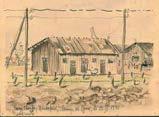
Louis Kahan, Untitled (Soldier), 1948
Rosenthal (later Westheimer) was born. Donated by Evelyne’s widower, Robert Westheimer.
3. Louis Kahan Collection: Untitled (Soldier), 1948, by prominent Austrian-born Australian artist Louis Kahan (1905-2002); one etching – Flight in Egypt 48/50. Donated by Lily Kahan, widow of Louis.
4. Judy Solomon Collection
A collection of dollhouse furniture, a birthday present for Hungarian-born Judy Solomon (nee Baneth) from her parents as a young child when they were in the Leipheim Displaced Persons Camp in Germany. The furniture was traded by a peddler. Donated by Judy Solomon.
5. Ruth Stein Collection
A range of documents and photographs belonging to French Resistance ghter, Ruth Kneppel (later Stein), who hid her Jewish identity while she went on various brave missions, sometimes with her infant daughter Michelle (see image of document above.) Donated by Michelle Huppert, Ruth’s daughter.
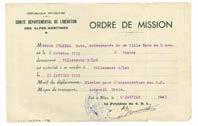
6. Eliahu Poratt Collection

Documents and photographs belonging to Eliahu Poratt, who survived camps including Auschwitz and Gross-Rosen. The family were from Lodz, Eli’s mother and little sister were murdered in Auschwitz; his father survived in the Soviet Zone. Eli went on an Aliyah Bet ship in 1946, and fought in the Golani Brigade in Israel’s War of Independence. Now 91, Eli has just given his testimony at the JHC. Donated by Eli Poratt.
7. Henry Borenstein Collection
Poetry written shortly after the war, by Henry Borenstein, who was a long-time volunteer at the JHC. Donated by David Borenstein, Henry’s son.
8. Romuald Mrozowski Collection
Diary belonging to Romuald Mrozowski, a young Pole who was taken prisoner after the Warsaw Uprising, and a photograph of Romuald. Some references indicate that he was likely to have had Jewish heritage. Donated by Brenda Hill, Romuald’s stepdaughter.
9. Sara and Chaim Zelcer Collection
Documents and photos belonging to Sara and Chaim Zelcer, who were Holocaust survivors from Lodz. Donated by Justin Zelcer, grandson.
10. Nellie Foley Collection
Photo album and documents belonging to Nellie Foley, an Australian nurse who assisted the recovery of survivors at the Bergen-Belsen DP Camp. Donated by Nellie’s grandson, Michael Neil.
11. Irene Sutton Collection
Eugene Aroneanu: Concentration Camps, crimes perpetrated against humanity, document 321, published by the Nuremberg War Crimes Tribunal, 1946. Donated by Irene Sutton.
32 JHC Centre News
Harry Choyke-Berkefeld, Maternity Barrack at Gurs, 1941
Ruth Kneppel (later Stein) Mission Order, 1945
Celebrating through giving
Ben Shaw celebrated his bar mitzvah in February and decided to forego gifts and instead ask for donations to the Jewish Holocaust Centre (JHC). Ben has visited Holocaust museums in both Sydney and America, and believes it is important to support the JHC in his home town.
Ben is a Year 8 student at Melbourne Grammar School and when his friends found out about his generous gesture, they thought it was ‘cool’ to donate to the JHC. Ben’s non-Jewish friends knew about the Holocaust, as they have participated in JHC education programs, and subsequently all donated. When asked why he chose to donate to the Centre, Ben said, ‘I realise the value of ensuring that the Jewish Holocaust Centre can continue its work, as I think it is important to keep the memory of the Holocaust alive for future generations.’
We thank Ben and his family and wish them a hearty Mazal tov. Ben’s decision to donate to the Centre shows he is already a mensch !

Dear Fredy
Co-presented by the Jewish Holocaust Centre, and screening as a part of the 2018 program, the Jewish International Film Festival presents Dear Fredy

Piecing together archive, animation and interviews, this new documentary explores the extraordinary life of Fredy Hirsch, a proud queer Jew who maintained a daycare centre for children in the Auschwitz Concentration Camp.
JIFF 2018: 24 October – 21 November
Do you have a simcha coming up?
If so, please consider donating to the Jewish Holocaust Centre in lieu of gifts so we can continue to keep the legacy of our Holocaust survivors alive.
For further information, please contact Danielle Kamien, email daniellek@jhc.org.au or phone 03 9528 1985.
JHC Centre News 33
JIFF.COM.AU 1628 BURWOOD HWY, BELGRAVE 675 GLENFERRIE RD, HAWTHORN 9 GORDON ST, ELSTERNWICK
(l-r) Leo, James, Josh, Leanne and Ben Shaw. Photo: Jeremy Blode
Mazal tov Halina Zylberman
The Jewish Holocaust Centre (JHC) is delighted to welcome Halina Zylberman to our 90th Birthday Club. Halina is a long-time volunteer who has worked tirelessly at the Centre as a museum guide for many years. We wish her Mazal tov !
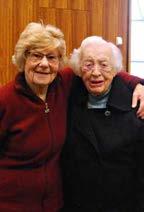
Ruth Mushin: editor extraordinaire
Michael Cohen
Acelebration, attended by staff and volunteers, was held at the Jewish Holocaust Centre (JHC) in July to mark Ruth Mushin’s 10th anniversary as Centre News editor.
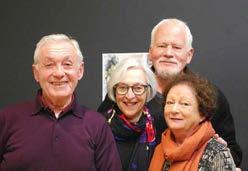
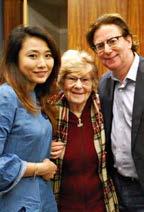
A decade or so ago, JHC co-president, Pauline Rockman OAM, met with Ruth and invited her to assume the editorship of the Centre’s flagship publication, Centre News – this at a time in Ruth’s career when she and her husband, Sam, had just sold their business. The timing, Pauline has said, was perfect. She was aware of Ruth’s superb skills as an editor of numerous biographies and autobiographies, inter alia. Pauline was also aware of Ruth’s outstanding work ethic: Ruth is a consummate professional.
Over the last decade, Ruth has edited 20 editions of Centre News, which is published twice yearly, soliciting articles from writers, academics and others, to produce a publication of genuine quality. Her professionalism is remarkable: whether planning the contents, approving the artwork, proofreading the text, or meeting deadlines.
The Jewish Holocaust Centre looks forward to many more highquality editions of Centre News under Ruth’s superb stewardship.
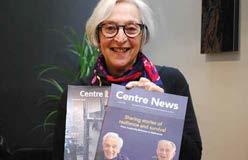
34 JHC Centre News
(l-r) Drisha Natarajan, Halina Zylberman and Mark White (l-r) Halina Zylberman and Irma Hanner
Dr Michael Cohen is JHC Director of Community Relations.
(l-r) Sam Helfenbaum, Ruth Mushin, Izi and Eti Marmur
Ruth Mushin
School visits 2017
Over 22,000 students from schools and universities across Victoria, as well as some from interstate and overseas, visited the Jewish Holocaust Centre last year. These are the schools that visited:
Aitken College
Albert Park College
Alexandra Secondary School
Alkira Secondary College
Alphington Grammar School
Antonine College
Aquinas College
Ashwood High School
Assumption College
Auburn High School
Ave Maria College
Avila College
Bacchus Marsh Grammar
Ballarat Clarendon College
Ballarat Secondary College
Balranald Central School
Balwyn High School
Bayside Christian College
Bayside P-12 College
Beaconhills College
Belmont High School
Bentleigh West Primary School
Berwick Secondary College
Berwick TEC
Beth Rivkah Ladies College
Bialik College
Billanook College
Birchip P-12 School
Boort District School
Box Hill Senior Secondary College
Braybrook College
Brentwood Secondary College
Bright Secondary College
Brighton Grammar School
Brighton Secondary College
Brunswick Secondary College
Carey Baptist Grammar School
Camberwell Girls Grammar School
Camberwell High School
Canterbury Girls Secondary College
Carwatha College
Caroline Chisholm Catholic College
Carrum Downs Secondary College
Casterton Secondary College
Cathedral College Wangaratta
Catholic College Bendigo
Catholic College Sale
Catholic Ladies College
Catholic Regional College Melton
Caulfield Grammar School
Chairo Christian School
Charlton College
Cheltenham Secondary College
Christian Brothers’ College
Citipointe Christian College
Clonard College
Cobram Anglican Grammar School
Cornish College
Corowa High School
Craigieburn Secondary College
CRC North Keilor
Damascus College
Dandenong High School
Daylesford Secondary College
De La Salle College
Deniliquin Christian School
Derrinallum P-12 College
Diamond Valley College
Dimboola Memorial SC
Donald High School
Doncaster Secondary College
Donvale Christian College
Dromana Secondary College
Drouin Secondary College
East Doncaster Secondary College
East Preston Islamic College
Echuca College
Eltham College
Emerald Secondary College
Emmanuel College
Encounter Lutheran College
Echuca College
Firbank Grammar School
Fintona Girls’ School
Fitzroy High School
FJC College
Flinders Christian Community College
Footscray City College
Foster Secondary College
Fountain Gate Secondary College
Frankston High School
Geelong Baptist College
Geelong High School
Geelong Lutheran College
Genazzano FCJ College
Gilson College
Gippsland Grammar
Gisborne Secondary College
Gladstone Park Secondary College
Glenaeon Rudolf Steiner School
Gleneagles Secondary School
Glen Eira College
Glen Waverley Secondary College
Glenroy College
Good News Lutheran College
Goulburn Valley Grammar School
Hazel Glen College
Heathdale Christian College
Highvale Secondary College
Highview College
Hillcrest Christian College
Hopetoun P-12 College
Hoppers Crossing Secondary College
Horsham College
Huntingtower School
Ilim College
Ivanhoe Grammar School
John Fawkner College
John Monash Science School
John Paul College
Kadina Memorial School
Kambrya College
Kaniva College
Kardinia International College
Kew High School
Keysborough Secondary College
Kilbreda College
King David School
King’s Christian College
King’s College Warrnambool
Kolbe Catholic College
Koonung Secondary College
Koo Wee Rup Secondary
Kyabram P-12 College
Lakeview Senior College
Lalor North Secondary
Lara Secondary College
Lauriston Girls School
Lavalla Christian College
Leibler Yavneh College
Lilydale High School
Loreto College
Lowther Hall AGS
Loyola College
Luther College
Lyndale Secondary College
Mackillop College
Macleod College
Manangatang P-12 College
Manor Lakes P-12 College
Marcellin College
Marian College Ararat
Marist-Sion College
Mater Christi College
McClelland College
McKinnon Primary School
Melbourne Grammar School
Melbourne Girls College
Melbourne Girls Grammar
Melbourne High School
Melton Christian College
Melton Secondary College
Mentone Girls Secondary
Mentone Grammar
Mercy College MacKay
Mercy Regional College
Meridian School
Mill Park Secondary College
Mirboo North Secondary College
MLC
Monivae College
Mooroolbark College
Mornington Secondary College
Mount Clear College
Mount Eliza Secondary
Mount Erin College
Mount Lilydale Mercy College
Mount Ridley P-12
Mount Scopus Memorial College
Mount St. Joseph Girls’ College
Mount Waverley Secondary
Murtoa College
Nagle College
Narre Warren South SC
Nathalia Secondary
Nazareth College
Newhaven College
Noble Park Secondary
Northern College
Notre Dame College
Nunawading Christian College
Oakwood School
Oberon High School
Our Lady of Mercy College
Our Lady of Sion College
Our Lady of the Sacred Heart
Overnewton Anglican College
Oxley Christian College
Pakenham Secondary College
Padua College Rosebud
Padua College Mornington
Parkdale Secondary College
Pascoe Vale Girls College
Patterson River Secondary
Peninsula Grammar
Penleigh and Essendon Grammar
Phoenix P-12 College
Princes Hill Secondary College
Reservoir High School
Ringwood Secondary College
Riverside Christian College
Rochester Secondary College
Rosebud Secondary College
Rosehill Secondary College
Rowville Secondary College
Roxburgh College
Rutherglen High School
Ruyton Girls’ School
Sacre Coeur
Sacred Heart Girls College
Sale College
Salesian College
Santa Maria College
Scotch College
St Aloysius College
St Augustine’s College
St Bede’s College
St Bernard’s College
St Brigid’s College
St Catherine’s School
St Dominic’s Primary School
St Francis Xavier College
St Helena Secondary College
St John’s College
St Joseph’s College
St Mary MacKillop College
St Mary’s College
St Mary’s of the Angels
St Peter’s College
Seymour College
Shepparton ACE College
Shepparton High School
Siena College
Southern Cross Grammar
Star of the Sea College
Staughton College
Strathcona BGGS
Strathmore Secondary
Sunbury College
Swifts Creek P-12 School
Swinburne Senior Secondary
Sydney Road Community College
Tarneit Senior College
Temple Christian College
Templestowe College
The Grange P-12 College
The Hamilton & Alexandra College
The Knox School
Thomas Carr College
Thornbury High School
Timbarra P-9 College
Tintern Grammar
Trinity College
University High School
Upper Yarra Secondary
Upwey High School
Urrbrae Agricultural High School
Vermont Secondary College
Victoria University Secondary
Victory Lutheran College
Wallan Secondary College
Wanganui Park Secondary
Warracknabeal Secondary
Warrnambool College
Waverley Christian College
Wellington Secondary College
Werribee Secondary College
Wesley College
Western Port Secondary College
Whittlesea Secondary College
Wonthaggi Secondary College
Woodleigh School
Xavier College
Yarra Hills Secondary
Yarra Valley Grammar
Yarram Secondary College
Yarrawonga College
Yea High School
Yeshivah College
JHC Centre News 35
Engagement
To David Prince on the engagement of his grandson Jeremy Prince to Victoria Spernat
Marriages
To Sharonna and David Brott on the marriage of their son Simon Brott to Romy Davidov
To Sandra and Henri Korn on the marriage of their grandson Adam Serry to Jessica Holsman
To Judy and Joe Szwarcberg on the marriage of their granddaughter Cara Szwarcberg to Daniel Avrahami
Births
To Sara Albeck on the birth of her granddaughter Zoe Albeck
To Goldie and Irving Birch on the birth of their grandson Elijah Birch
To Viv Bolaffi on the birth of her granddaughter Zara Black
To Beryl and Trevor Chitiz on the birth of their granddaughters Evie and Milla Cahill
To Anita and Peter Frayman on the birth of their grandson Jack Frayman
Mazal tov
To Anna and Ralph Glezer on the birth of their granddaughter Eden Glezer
To Rocky and Alan Kozica on the birth of their granddaughter Cecilia Kozica
To Annette Leski on the birth of her granddaughter Mia Lipshutz and grandson Joseph Leski
To Ariella Leski and Joshua Lipshutz on the birth of their daughter Mia Lipshutz
To Judy Lipshutz on the birth of her granddaughter Adele Lasnitzki and grandson Jonah Sacks
To David and Leah Schulberg on the birth of their granddaughter
Henrietta Schulberg
To Tamar and Robbie Simons on the birth of their son Leon Wolf
To Riva and Harvey Same on the birth of their grandson Asher Same
To Mary and Peter Stawski on the birth of their grandson Hugo Frost and granddaughter Lily Stawski
Bar/Bat Mitzvah
To Juanita and Joe Bekinschtein, on the bar mitzvah of their grandson Julian Bekinschtein
To Pauline Rockman OAM on the bar mitzvah of her grandson Julian Bekinschtein
Condolences
To Nicole and David Herzog on the bar mitzvah of their son Marc Herzog
To Ellie and Dean Smorgon on the bar mitzvah of their son Toby Smorgon
Birthdays
To Jeremy Adler on his 30th birthday
To Julia Reichstein on her 40th birthday
To Nicky Pick on her 50th birthday
To Carol Armener on her 70th birthday
To Allen Brostek on his 70th birthday
To Elaine Davidoff on her 70th birthday
To Jack Ginger on his 70th birthday
To Helen Mahemoff on her 70th birthday
To Ilona Oppenheimer on her 70th birthday
To Jeanine Rockawin on her 70th birthday
To Stephen Schmideg on his 70th birthday
To David Burstin on his 80th birthday
To Clara Weis on her 90th birthday
To Joe de Haan on his 95th birthday
To Phillip Maisel OAM on his 95th birthday
To Danny and Eva Jaffe on the death of their mother and mother-in-law Vicky Jaffe
To Kathy and Les Janovic on the death of their father and father-in-law Alex Resofsky and mother and mother-in-law Judy Resofsky
To Suzie and Stephen Kleid on the death of their father and father-in-law Alex Resofsky and mother and mother-in-law Judy Resofsky
To Rosa Krakowski on the death of her sister Lola Skupski
To Sean and Rosi Meltzer on the death of their mother and mother-in-law Yudice Meltzer
To Sydney Pilcer and Sharon Felzen on the death of their father and father-in-law Abraham Pilcer
To Therese Ungar on the death of her husband Kurt Ungar
In Loving Memory of
My parents Moshe Szyja and Masha Cykiert and siblings Adela, Mirla, Sulen Yizthok, Bluma, Bajla Miriam and Abraham Cykiert
Remembered by daughter Tova Tauber, children and grandchildren
36 JHC Centre News
Regina Adelfang
Anonymous































































Erika Bence







Elza Bernst
Susan Blatman
Gitla Borenstein
Joseph Brown AO OBE
Majer Ceprow
Richard Charlupski
Bertha Fekete
John Fox
Jakob Frenkiel
Cecilia Freshman
Romana Frey
Sara Frucht
Walter Geismar
Fania Gitein
Estate gifts
We acknowledge the Jewish Holocaust Centre and Foundation bequestors for their generosity and vision. May their memory be a blessing.
Samuel Gnieslaw
Arnold Hacker
Bessie Heiman
Mendel Herszfeld
Magda Horvat
Sabina Jakubowicz
Betty Janover
Basia Kane
Thea Kimla
Lola Kiven
Leslie Klemke
Izabella Krol
Eva Rivka Knox
Pinek Krystal
Nona Lee
Ivor Leiser
Ruth Leiser
Charlotte Lesser
Kurt Lewinski
Sara Liebmann
Julek & Ada Lipski
Abram Malewiak
Janina Marcus
Don Marejn
Anna Mass
Sonia Mrocki
Victor Muntz
Kalman & Elka Bajla Parasol
Edith Peer
Elizabeth Peer
Lilian Renard
Gerda Rogers
Beatrice & Rose Rosalky
Hadasa Rosenbaum
Shmuel Rosenkranz
Szmul Rostkier
Bencjan Rozencwajg
Shmuel Rosenkranz
Irene & Ignacy Rozental
Leslie Sandy
Joseph Scharf-Dauber
Helen Sharp
Otto Shelton
Raymond Harry Schiller
Marianne Singer
Sara Smuzyk
Owsiej Sokolski
Mary Starr
Georgette Steinic
Samuel Stopnik
Berta Strom
Sonia Suchodolski
Geoffrey Tozer
Josef Tyler
Chana Annette Uberbayn
Emanuel Wajnblum
Kathe Weisselberg
Ludvik Weisz
Hannah Wiener
Pinkus Wiener
Sabina Winter
Ludwik & Rita Win eld
Chaya Ziskind
So a Zitron
If you are interested in leaving a bequest to the JHC or require further information please contact Leora Harrison on (03) 9528 1985 or Leorah@jhc.org.au.
Become a Partner in Remembrance

The Jewish Holocaust Centre Foundation ensures the continued existence of the Centre and supports its important work. Funds raised through the Foundation are invested, with the earnings providing an ongoing source of income for the Centre to support its operations and programs into the future.
For more information on how you can help support the Foundation and how your support will be recognised, please contact Helen Mahemoff, Chair of the Foundation on 0417 323 595 or email jhcfoundation@bigpond.com.
JHC Centre News 37













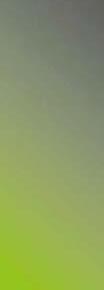









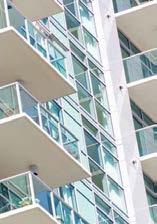






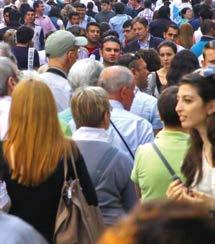
38 JHC Centre News
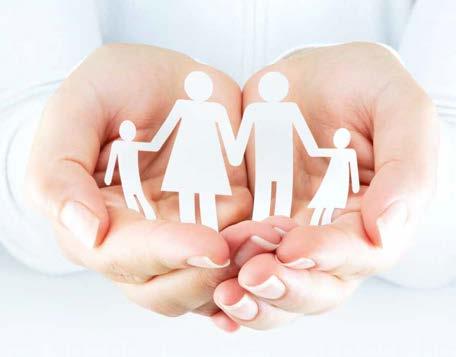
JHC Centre News 39 GaryPeer.com.au Caulfield 9526 1999 Carnegie 9563 1666 St Kilda 9066 4688 Bentleigh 8842 6800 Property Management 9526 1988 New Residential Collections 9526 1999 We make a living by what we get. We make a life by what we give.
Gary Peer & Associates proudly supports The Jewish Holocaust Centre





40 JHC Centre News ADVERTISING If you would like to advertise in this section please contact Danielle Kamien Email: daniellek@jhc.org.au Phone: (03) 9528 1985
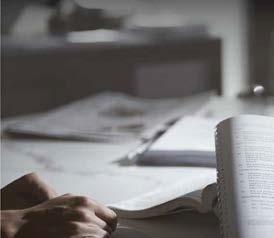





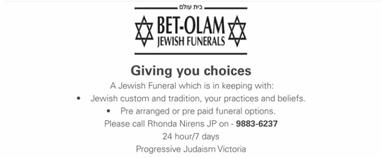
JHC Centre News 41
דנַאטשפֿיוא־ָאטעג רעוועשרַאוו םעד ןרעַאב סעינָאמערעצ ערעדנַא רָאג ייווצ :סטרעווראָפֿ ןופֿ ךירָאנ לאומש 20.04.2018 .
,עשרַאוו ןיא רידנַאמָאק־
זַא ,טנָאטַאב רעד „ סע סע ‟
ענַײז ןיא ןבירשעג טָאה ,פּורטש ןגרִיי לַארענעג
יד
זַא ,ןילרעב ןיא ןרידנַאמָאק ענַײז רַאפֿ ןטכירַאב
„
ןדִיי יד טימ טקינייארַאפֿ ךיז ןבָאה ןטידנַאב עשיליופּ
.ןטַאדלָאס ׳סע־סע׳ יד ףיוא ןסיש וצ ידכּ ‟
־ןברוח םעַײנ סנליופּ ףיוא ףו
יד זַא ,ןהנעט סָאוו יד
רפָּא ןטקערידמוא ןַא ןיא
זַא ,טגָאזעג ַאדוד טָאה ,ץעזעג „
רעביא דיצָאנעג םעניא קידלוש ךיוא ןענעז ןקַאילָאפּ
רעקלעפֿ עדייב ןעלוועַאב ,ןדִיי יד
ןטימ ןסָאלשעג ךיז טָאה עינָאמערעצ עלעיציפָֿא יד ָא ןוא ןשטנעמ יד ןופֿ ןעמענ יד ןפֿורסיוא
סעיצַאזינַאגר
טשינ .דנַאטשפֿיוא םעניא ןעמונעג לייטנָא ןבָאה סָאוו
עטייווצ יד ןביוהעגנָא ךיז טָאה םעד ךָאנ גנַאל עלימ ןיא עינָאמערעצ 18 .
םעד טכַארבעגפֿיונוצ טָאה סָאוו ,עינָאמערעצ יד „ ריעצה רמושה „ ,” ”רורד םעד ןוא „ ,”דנוב טָאה פֿנעזָאר עלעגייפֿ טריזינַאגרָא
ןופֿ רעטכָאט יד
דלע —
רעד ךָאנ ןבָאה סָאוו ענעבילבעג־ןבעל רעוועשרַאוו לָאערטנָאמ ןיא טלקימ־םוקמ ַא ןענופֿעג המחלמ — םענופֿ עיצַאגעלעד ַא טימ ןעמַאזוצ
„
־רעטעברַא .‟גניר
ןוא שידִיי ףיוא ןעמ טָאה םַארגָארפּ רעד ןיא ןופֿ ןבירשעגנָא ,רעדיל טנעיילעגרָאפֿ שילגנע ב רעד ןיא ןטסינויצ עשיטסילַאיצָאס ןוא ןטסידנו
סָאוו תונורכז ךוב םענופֿ גוצסיוא ןַא ךיוא יוו ,ָאטעג
עקדַאלוו ןירעגנערב־תועידי ןוא ןירעפֿמעק־ָאטעג יד ןיא ןבעגעגעגסיורַא טָאה דימ „—1947
ר׳׳ד ,ןוז ריא ןופֿ טנעיילעגרָאפֿ
עדייב ןופֿ רעיומ־ָאטעג ןטַײז ,‟
ימ ןעוויטס .ד
ןיא ,גוצסיוא ןַא טנעיילעגרָאפֿ אקווד טָאה דימ ר׳׳ד
,טגָאלקַאב רעטיב ךיז טָאה דימ עקדַאלוו ןכלעוו
יד ןוא גנוגעווַאב
עשידרערעטנוא
ןבעג וצ טגָאזעגפָּא ךיז ןבָאה
עשיליופּ יד תמחמ עשיליופּ „‟יימרַא־םייה
,ןסקיב עקיצנייא יד .רעפֿמעק עשידִיי יד רעוועג טַאנַארג
ָאי ןבָאה ייז סָאוו סרעפֿרַאוו־ןליוק ןוא ן
ַא קנַאד ַא ןעמוקעג ןענעז ןקַאילָאפּ ןופֿ ןעמוקַאב
:עפּורג רעשידרערעטנוא רעטייווצ „
ַאדוד טנעדיזערפּ .עשיטסינומָאק ַא אקווד
־סקלָאפֿ יד ‟,יימרַא
טנָאמרעד טינ טרפּ םענעי ,ךיז טייטשרַאפֿ ,טָאה ןיא פַּאר רַאפֿ ,טנווָא
ןעמוקעגרָאפֿ זיא עוטַאטס סטרָאפַּא ןשינָאפֿמיס ַא טימ טרעצנָאק רעכעלטנפֿע ןַא ןוא רעטסעקרָא רעד .רָאכ ןלופֿ ַא ןוא רעטסעקרָא
סנעווָאטייב ןופֿ לייט ַא טלעטשעגרָאפֿ ןבָאה רָאכ .עינָאפֿמיס רעטנַײנ
19ןט ,לירפַּא .2018 ַא ןיא רעוועשרַאוו יד ןבָאה גָאטגנילירפֿ ןקינוז םענייש ,דנַאלסיוא ןופֿ ןדִיי טימ ןעמַאזוצ ,רעניווונַײא
םעד ,קיטשרענָאד
ָאד ךיז טָאה סָאוו דנַאטשפֿיוא םעד טקרעמעגפָּא
75 קירוצ רָאי . קידנקוק זַא ,ןעמ טעז רעייגַײברַאפֿ יד ףיוא
טימ גָאט םעד ןיא ןביוהעגנָא
ַא יצ לטירד ַא עלעג ןגָארט ןסַאג יד ףיוא ןשטנעמ יד ןופֿ לטרעפֿ
רעטרעוו יד טימ ןסיצרַאנ ענעריפַּאפּ „רעוועשרַאוו םעד ,דנַאטשפֿיוא־ָאטעג
19
לירפַּא ןט 1943‟. יד םענעזעוועג םענופֿ טריזירַאלופָּאפּ לָאבמיס ַא ןעמולב ןבָאה ,ל׳׳ז ןַאמלדייא קערַאמ רעפֿמעק־ָאטעג וצ גנַאגנַײרַא םַײב ךעלדיימ ןוא ןעיורפֿ עגנוי טלייטעג
סעיצנַאטס־סובָאטיוא ןוא ־ָארטעמ יד וצ . טכליהעגפָּא ענעריס ַא טָאה גָאט ןבלַאה םוא טקנופּ ,טלעטשעגפָּא ךיז טָאה יז רָאנ יוו .טָאטש רעד רעביא ־קנעדנָא עשיכולמ עלעיציפָֿא יד ןביוהעגנָא ךיז טָאה ןבעל עינָאמערעצ רעטמירַאב סטרָאפַּאפַּאר ןתנ רעשיליופּ רעד .רעפֿמעק־ָאטעג יד ןופֿ עוטַאטס ,םלוע ןרַאפֿ טדערעג טָאה ,ַאדוד יירדנַא ,טנעדיזערפּ
,ןליופּ ןיא ןירָאדַאסַאבמַא עקידלארשׂי יד ךיוא יוו םענופֿ טנעדיזערפּ רעד ןוא ,ירזַא הנַא „ ־טלעוו ןשידִיי ‟סערגנָאק עדוַאל דלַאנָאר ר
יד ןופֿ ןדִיי עפּורג ַא טָאה רעטעפּש העש ייווצ טימ
ַא טריפֿעגכרוד עדַאנַאק ןוא ןטַאטש עטקינייארַאפֿ עלימ ןיא עינָאמערעצ עטייווצ 18 םענופֿ טרָא סָאד , יד ןופֿ רעריפֿנָא ךס ַא ןכלעוו ןיא רעקנוב רידנַאמָאק םעד טנכערעגנַײרַא ,רעלדנעטשפֿיוא
שטיוועלעינַא יכדרמ
ןבָאה ייז זַא ןוא „ןעמוקַאב
ןרָאוועג טרעגַאלַאב ןענעז , הרכּזה יד .ןעמוקעגמוא ףוס םוצ ןוא ןשטַײד יד ךרוד רעד ןופֿ רעקנוב םענעזעוועג םַײב „ ־ףמַאק רעשידִיי ‟עיצַאזינַאגרָא רעדנַא רָאג ַא ןבעגעגרעביא טָאה עדער סַאדוד טנעדיזערפּ יוו וויטקעפּסרעפּ . ַאדוד ָאטעג עשידִיי יד זַא ,טנָאטַאב טָאה ןענעז רעפֿמעק־ ןבָאה סָאוו ,רעגריב עשיליופּ ןעוועג „טזָאלעג יד יד ַײס ,ןָאפֿ עשידִיי עסַײוו־יולב יד ַײס ןרעטַאלפֿ ,עשיליופּ עסַײוו־טיור ‟
סרעפֿרַאוו־ןליוק ןוא ןסקיב ‟ רעשיליופּ רעד ןופֿ
.גנוגעווַאב רעשידרערעטנוא ַאדוד טָאה ,וצרעד ןגעוו טסוּוורעד ךיז טָאה טלעוו יד זַא ,טרעלקרעד
ןיא גנוריגער עשיליופּ יד לַײוו ,דנַאטשפֿיוא םעד רעד ןסיוו טזָאלעג טָאה תולג „‟.יס־יב־יב טָאה ַאדוד ַא טימ ןרָאוועג טיילגַאב זיא קיזומ יד „־טכיל ‟לקַאטקעפּס
רעצַארק־ןקלָאוו ַא ףיוא טריטקעיָארפּ
42 JHC Centre News
.‟
טכעלטנפֿערַאפֿ :סטרעווראָפֿ ןופֿ ילייה .ןהכּ 09.05.2018
,רעמַאקזַאג םוצ געוו ןפֿיוא יורפֿ רעשידִיי ַא ןופֿ ווירב
םיא ךיא לָאז סָאוו רַאפֿ׳ :ךיז ַײ
ב טכַארטעג בָאה ךיא
ןענעק ךיוא סע ןלָאז ערעדנַא זַא ,ןטיירפּשרַאפֿ טינ
עטסערג ענַײמ ןופֿ ענייא
‟׳?ןעז .טגָאזעג רע טָאה „
יד ןעקנעדעג טעוו רעוו׳ :ןעוועג קידנעטש זיא ןגרָאז
ךיז ךיא ףרַאד טציא ?רעמ ָאטינ ןיב ךיא זַא עמַאמ
זַא
ןגרָאז טינ רעמ .‟ רוח רעד רעביא טָאה ייזומ־ןב גנוטַײצ רעד ןבעגעג „‟,רַאטס־סילָאפַּאנַאידניא
טינ טסייוו רענייק .לַאקינוא ,םינפּ ַא ,זיא ווירב רעד
ןַא ,דלַאוונורג קנערפֿ טָאה ןרָאי רעקילדנעצ
םעד ןענעייל טלָאוועג טינ ,בֿשותּ רעסילָאפַּאנַאידניא
ץיוושיוא ןיא ןבירשעגנָא טָאה עמַאמ ןַײז סָאוו ,ווירב
רעמַאקזַאג ןיא ןַײרַא זיא יז רעדייא ךַײלג .
ןַײז רעבָא ץיוושיוא טבעלעגרעביא טָאה דל
ַאוודנורג
ןטרָאד ןענעז רעדורב ןַײז ןוא ַאמליוו עמַאמ
זיא עמַאמ יד רעדייא ךַײלג .ןעמוקעגמוא
ַא ןבירשעגנָא יז טָאה ,רעמַאקזַאג ןיא ןעגנַאגעגנַײרַא
שממ ןבירשעג טָאה עמ סָאוו ,ווירב ַאזַא ךָאנ ןופֿ
ךיז טָאה סָאוו ןוא רעמַאקזַאג ןופֿ לעווש ןפֿיוא
טנַײה זיב טיהעגפָּא
יוזַא ךיז טנעייל וו :
רעקנירעַײט ןַײמ ,רעקיצנייא ןַײמ ,וד —
ַא ןבעגעגרעביא םיא ןוא טרוק ןַאמ ריא רַאפֿ ווירב
ךעלנעזרעפּ ט
ארומ בָאה ךיא
ָאה רעטכעוו רעד .רעטכעוו ןשישטַײד
ןַאמ ריא ווירב םעד ןבעגעגרעביא
„
ירב רעצנַאג רעד
רעד טגָאזעג
דלַאוונורג טָאה
,ווירב ןרַאפֿ טַאהעג ‟
רַאטס־סילָאפַּאנַאידניא ‟ .
גנוטַײצ „
„
ןבָאה רימ .ךשוח ןפֿיוא רימ ןטרַאוו טרילָאזיא
סָאד ןסָאלשַאב רעבָא ןטלַאהַאב ךיז ןגעוו טרעלקעג
יד .גנונעפָֿאה ןייק ןעוועג טינ זיא׳ס לַײוו ןָאט וצ טינ
רימ ןוא ָאד ןיוש ןענעז סָאטיוא־אשׂמ עטמירַאב
ןיא ןיב ךיא .ןבייהנָא דלַאב ךיז טעוו סע .ןטרַאוו ,רעטסרעַײט ןוא רעקיצנייא ןַײמ ,וד .קִיור ןצנַאג
זיא׳ס סָאוו ןיא ןיילַא טינ ךיז קידלושַאב
רימ .לרוג רעזדנוא ןעוועג זיא יוזַא .ןעמוקעגרָאפֿ
עשז בַײלב .טנעקעג ןבָאה רימ סָאוו ןָאטעג ןבָאה
טָאה ַאזַא ןוא ךיז : „ רעקנירעַײט ,רעקיצנייא רימ זיא .טנעקעג
המחלמ יד ןעוו טלַא רָאי
ןעוועג זיא דלַאוונורג 11
ךַײלג םיא טָאה רעטָאפֿ ןַײז .טקידנעעג ךיז טָאה
טינ טָאה דלַאוונורג רעבָא ווירב םעד ןגעוו טלייצרעד
ןַײז ךָאנ זיב ןענעיילוצרעביא םיא טומ םעד טַאהעג
. 11 ןעוו טָאה ךָאנ 1967.
םיא בָאה ךיא .ןרָאוועג לעג ןיוש זיא ריפַּאפּ רעד
ןיא הריטפּ סנטַאט 1967 . „
,זיא סָאד סָאוו טסוּוועג ךַײלג ןוא ןעזעג ‟ רע טָאה .טגָאזעג „
סנעמַאמ רעד טנעקרעד בָאה ךיא סָארדרַאפֿ ,סעכּ ןייק סיוא טינ טקירד יז .טפֿירשטנַאה
טימ זַא ע זיא
טַײצ רעד טימ זַא רעטרעוו ע
נַײמ קנעדעג ןוא טנוזעג
ךיז טלדנַאה סע .ןשטַײד יד ןגעק טייקרעטיב רעדָא
וטסעוו —
לייט םוצ שטָאכ זיא ,ןצנַאג ןיא טינ ביוא — עלעגנִיי ענעדלָאג סָאד ףיוא טיה .ןלייהסיוא ךיז .עביל ןַײד טימ ליפֿ וצ טינ םיא עשטשעיפּעצ ןוא
ןכעלרעדנוּוו ַא טָאה .עדייב ריא טנוזעג עשז טבַײלב
טבַײלב
א־אשׂמ יד ןיא ןַײרַא ןזומ רימ .ןבעל סָאטיו . טייקיבייא רעד זיב , ַאמליוו .‟
.סָאטיו
פֿ ןַײמ ןגעוו זיולב
רעד ןגעוו ,ךיא ןוא רעטָא .‟טפֿנוקוצ
םעד ןזיוועג טינ םענייק דלַאוונורג טָאה ןרָאי עגנַאל
רָאי ריפֿ טימ .ַארַאברַאב יורפֿ ןַײז וליפַֿא טינ ,ווירב
םעד ווירב םעד ןבעגעגרעביא רע טָאה קירוצ
ןָאטגנישַאוו ןיא ייזומ־ןברוח ןשיכולמ רעקנַאירעמַא .
םיובלעגיז לאומש " : טשינ ךיא ןעק ןבעל ןוא טשינ ךיא ןעק ןגַײווש ‟.
ןופֿ ענצַײוו יבָאק .ר 30.05.2018
גנולעטשסיוא עַײנ ַא ןגעוו
,םיובלעגיז
ןעגנַאגַאב םיובלעגיז זיא ווירב םעד ןקיש ןכָאנ הריד רענָאדנָאל ןַײז ןיא דרָאמטסבלעז
םעניא גנולעטשסיוא עַײנ ַא טנפֿעעג טָאה עמ „ןשידִיי טוטיטסניא ןשירָאטסיה ‟ טסייה סָאוו ,עשרַאוו ןיא
ןעוועג זיא ,אַ ופֿ גיהנמ םענ ןדִיי
רָאי ןיא ןריובעג 1895 ןעוועג זיא , אַ ופֿ גיהנמ םענ „‟דנוב
ןַײז
גנוריגער רעשיליופּ רעד ןופ דילגטימ ַא ןוא המחלמ־טלעוו רעטייווצ רעד תעשב ןָאדנָאל ןיא
םעד ןגעק טסעטָארפּ ַא ןעוועג זיא דרָאמטסבלעז
גנוקיליטרַאפֿ רעד עגונב טלעוו רעד ןופֿ טליגכַײלג
ןטריפּוקָא ןיא ןשטַײד יד ךרוד ןדִיי עשיליופּ יד ןופֿ .ןליופּ
רענפֿאַד סקעלאַ ךרוד טלעטשעגנעמאַזוצ
„ ןבעל ןוא טשינ ךיא ןעק ןגַײווש .םיובלעגיז לאומש טשינ ךיא ןעק ‟. ַײמ ןטפֿלע םעד 1943 לאומש טָאה ןשיליופּ םוצ ווירב ןלעיציפָֿא ןַא ןבירשעג םיובלעגיז .שטיוועיקשטַאר ווַאלסידַאלוו ,תולג ןיא ןטנעדיזערפּ
:ןענעז ווירב םענופֿ רעטרעוו עטסטנַאקַאב יד „ א ןעק ןגַײווש ןעוו טשינ ךיא ןעק ןבעל ןוא טשינ ךי ךיא סָאוו ןליופּ ןיא קלָאפֿ ןשידִיי םענופֿ ךעלטשער יד םוא ןעמוק ,ריטנעזערפּער
JHC Centre News 43
.‟
.
.
, 1943
SEPTEMBER 2018 The magazine of the Jewish Holocaust Centre, Melbourne, Australia
Betty Shmuel& Rosenkranz Oration
Sunday 11 November 2018
Keynote SpeaKer: Michael Berenbaum
Time: 7:00pm
Venue: St Kilda Town Hall, 99A Carlisle Street St Kilda, Victoria
Bookings: Please check the JHC website for details.
MiCHAel BerenBAuM is an American scholar, museum and film consultant who specialises in the study of the Holocaust.
He is Professor of Jewish Studies and Director of the Sigi Ziering Institute: Exploring the Ethical and Religious Implications of the Holocaust, located at the American Jewish University.
He is the author of many books, including The World Must Know and Anatomy of the Auschwitz Death Camp, as well as many scholarly articles and journalistic pieces.
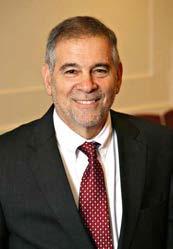














 Genia Janover
Genia Janover

 -Dr Anna Hirsh, Senior Archivist
-Dr Anna Hirsh, Senior Archivist






























































































